
Friday | July 2, 2021

The Hand That Rocks the Cradle (1992).
DB here:
“Every film trains its spectator,” I wrote a long time ago. In other words: A movie teaches us how to watch it.
But how can we give that idea some heft? How do movies do it? And what are we doing?
Many menus
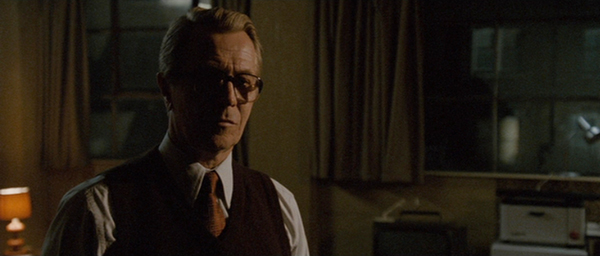
Tinker, Tailor, Soldier, Spy (2011).
In my research, I’ve found the idea of norms a useful guide to understanding how filmmakers work and how we follow stories on the screen. A norm isn’t a law or even a rule; it’s, as they say in Pirates of the Caribbean, more of a guideline. But it’s a pretty strong guideline. Norms exert pressure on filmmakers, and they steer viewers in specific directions.
Genre conventions offer a good example. The norms of the espionage film include certain sorts of characters (secret agents, helpers, traitors, moles, master minds, innocent bystanders) and situations (tailing targets, pursuits, betrayal, codebreaking, and the like). The genre also has some characteristic storytelling methods, like titles specifying time and place, or POV shots through binoculars and gunsights.
But there are other sorts of norms than genre-driven ones. There are broader narrative norms, like Hollywood’s “three-act” (actually four-part) plot structure, or the ticking-clock climax (as common in romcoms and family dramas as in action films). There are also stylistic norms, such as the shoulder-level camera height and classic continuity editing, the strategy of carving a scene into shots that match eyelines, movements, and other visual information.
Thinking along these lines leads you to some realizations. First, any film will instantiate many types of norms (genre, narrative, stylistic, et al.). Second, norms are likely to vary across history and filmmaking cultures. The norms of Hollywood are not the same as the norms of American Structural Film. There are interesting questions to be asked about how widespread certain norms are, and how they vary in different contexts.
Third, some norms are quite rigid, as in sonnet form or in the commercial breaks mandated by network TV series. Other norms are flexible and roomy (as guidelines tend to be). There are plenty of mismatched over-the-shoulder cuts in most movies we see, and nobody but me seems bothered.
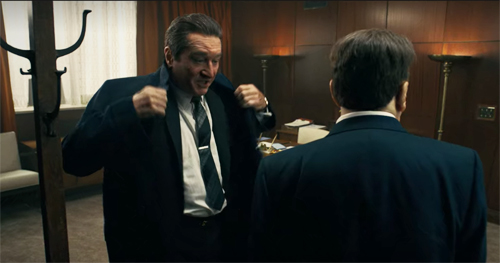 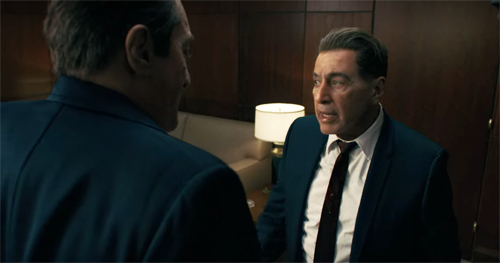
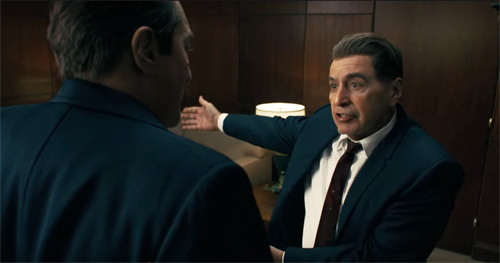 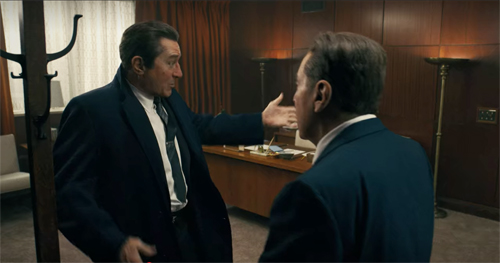
More broadly, norms exist as options within a range of more or less acceptable alternatives. Norms form something of a menu. In the spy film, the woman who helps the hero might be trustworthy, or not. The apparent master mind could turn out to be taking orders from somebody higher up, perhaps somebody supposedly on your side. One scene might avoid continuity editing and instead be presented in a single long take.
Norms provide alternatives, but they weight them. Certain options are more likely to be chosen than others; they are defaults. (Facing a menu: “The chicken soup is always safe.”) An action film might present a fight or a chase in a single take (Widows, Atomic Blonde), but it would be unusual if every scene in the film were played out this way. Not forbidden, but rare. Avoiding the default option makes the alternative stand out as a vivid, willed choice.
Very often, critics take most of the norms involved for granted and focus on the unusual choices that the filmmakers have made. One of our most popular entries, the entry on Tinker, Tailor, Soldier, Spy, discusses how the film creates a demanding espionage movie by its manipulations of story order, characterization, character parallels, and viewpoint. It isn’t a radically “abnormal” film, but it treats the genre norms in fresh ways that challenge the viewer.
Because, after all, viewers have some sense of norms too. Norms are part of the tacit contract that binds the audience to creators. And the viewer, like the critic, looks out for new wrinkles and revisions or rejections of the norm–in other words, originality.
Picking from the menu
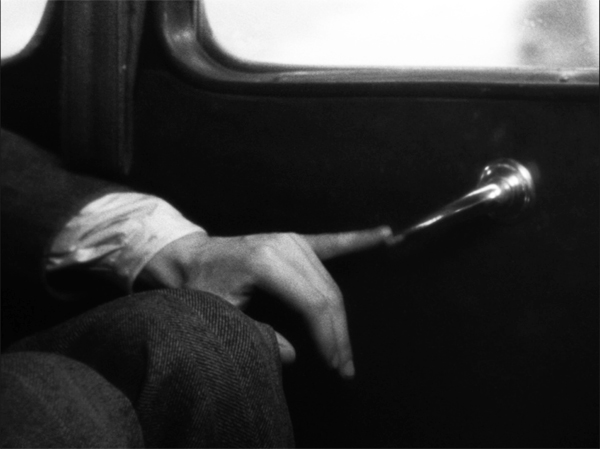
Norms of genre, narrative, and style are shared among many films in a tradition or at a certain moment. We can think of them as “extrinsic norms,” the more or less bounded menu of options available to any filmmaker. By knowing the relevant extrinsic norms, we’re able to begin letting the movie teach us how to watch it.
The process starts early. Publicity, critical commentary, streaming recommendations, and other institutional factors point up genre norms, and sometimes frame the film in additional ways–as an entry in a current social controversy (In the Heights, The Underground Railroad), or as the work of an auteur. You probably already have some expectations about Wes Anderson’s The French Dispatch.
Then, as we get into the film, norms quickly click into place. The film signals its commitment to genre conventions, plot patterning, and style. At this point, the film’s “teaching” consists largely of just activating what we already know. To learn anything, you have to know a lot already. If the movie begins with a character recalling the past, we immediately understand that the relevant extrinsic norm isn’t at that point a 1-2-3 progression of story events, but rather the more uncommon norm of flashback construction, which rearranges chronology for purposes of mystery or suspense. Within that flashback, though, it’s likely that the 1-2-3 default will operate.
As the film goes on, it continues to signal its commitment to extrinsic norms. An action scene might be accompanied by a thunderous musical score, or it might not; either way, we can roll with the result. The characters might let us into their thinking, through voice-over or dream sequences, or we might, as in Tinker, Tailor, be confronted with an unusually opaque protagonist whose motives are cloudy. The extrinsic norms get, so to speak, narrowed and specified by the moment-by-moment working out of the film. Items from the menu are picked for this particular meal.
That process creates what we can call “intrinsic norms,” the emerging guidelines for the film’s design. In most cases, the film’s intrinsic norms will be replications or mild revisions of extrinsic ones. For all its distinctiveness, in most respects Tinker, Tailor adheres to the conventions of the spy story. And as we get accustomed to the film’s norms, we focus more on the unfolding action. We’ve become expert film watchers. We learn quickly, and our “overlearned” skills of comprehension allow us to ignore the norms and, as we stay, get into the story.
Narration, the patterned flow of story information, is crucial to this quick pickup. Even if the film’s world is new to us, the narration helps us to adjust through its own intrinsic norms. The primary default would seem to be “moving spotlight” narration. Here a “limited omniscience” attaches us to one character, then another, within a scene or from scene to scene. We come to expect some (not total) access to what every character is up to.
In Curtis Hanson’s Hand That Rocks the Cradle, we’re initially attached to the pregnant Claire Bartel, who has moved to Seattle with her husband Michael and daughter Emma. When Claire is molested by her gynecologist Dr. Mott, she reports him. The scandal drives him to suicide, and his distraught wife miscarries. She vows vengeance on Claire. Thereafter, the plot shuttles us among the activities of Claire, Mrs. Mott, Michael, the household handyman Solomon, and family friends like Michael’s former girlfriend Marlene. The result is a typical “hierarchy of knowledge”–here, with Claire usually at the bottom and Mrs. Mott near the top. We don’t know everything (characters still harbor secrets, and the narration has some of its own), but we typically know more about motives, plans, and ongoing action than any one character does.
More rarely, instead of a moving spotlight, the film may limit us to only one character’s range of knowledge. Again, scene after scene will reiterate the “lesson” of this singular narrational norm. That repetition will make variations in the norm stand out more strongly. Hitchcock’s North by Northwest is almost completely restricted to Roger Thornhill, but it “doses” that attachment with brief asides giving us key information he doesn’t have. Rear Window and The Wrong Man, largely confined to a single character’s experience, do something similar at crucial points.
Sometimes, however, a film’s opening boldly announces that it has an unusual intrinsic norm. Thanks to framing, cutting, performance, and sound, nearly all of Bresson’s A Man Escaped rigorously restricts us to the experience of one political prisoner. We don’t get access to the jailers planning his fate, or to men in other cells–except when he communicates with them or participates in communal activities, like washing up or emptying slop buckets.
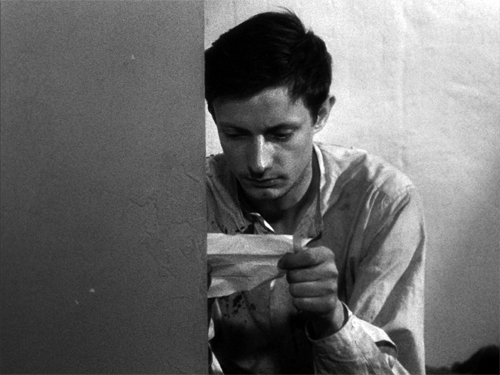 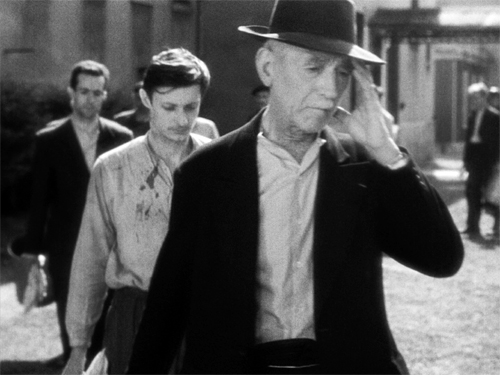
The apparent exception: The film’s opening announces its intrinsic norm in an almost abstract way. First, we get firm restriction. There are fairly standard cues for Fontaine’s effort to escape from the police car that’s carrying him. Through his optical POV, we see him grab his chance when the driver stops for a passing tram.
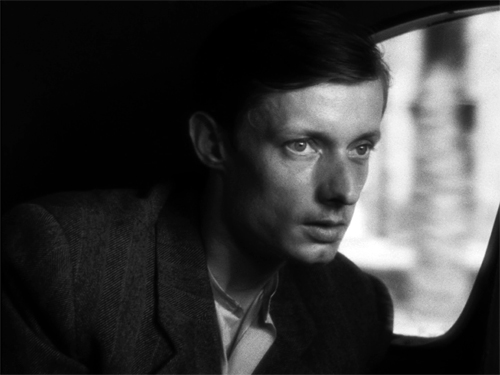 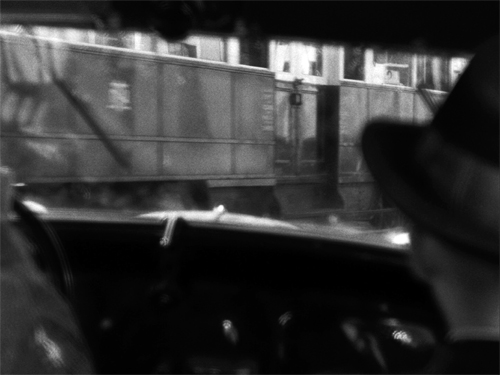
The film’s title and the initial situation let us lock onto one extrinsic norm of the prison genre: the protagonist will try to escape. Knowing that we know this, Bresson can risk a remarkable revision of a stylistic norm.
Fontaine bolts, but Bresson’s visual narration doesn’t follow him. The camera stays stubbornly in the car with the other prisoner while Fontaine’s aborted escape is “dedramatized,” barely visible in the background and shoved to the far right frame edge. He is run down and brought back to be handcuffed and beaten.
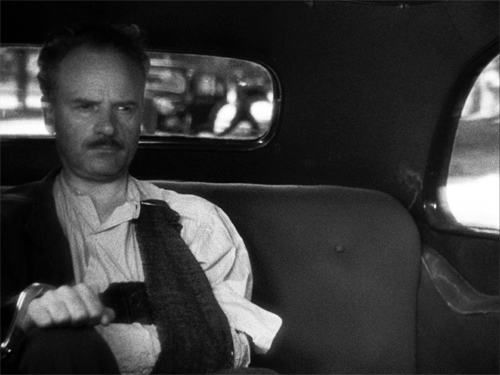 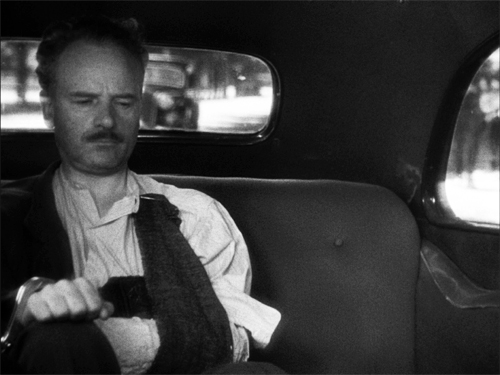
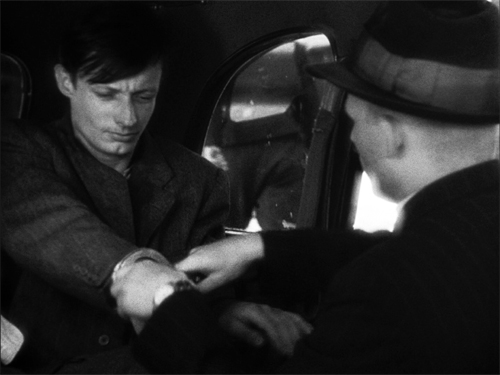 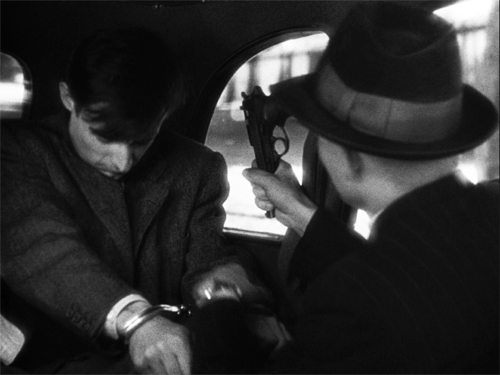
The shot announces the premise of spatial confinement that will dominate the rest of the film. The narration “knows” Fontaine can’t escape and waits patiently for him to be dragged back. In effect, the idea of “restricted narration” has been decoupled from the character we’ll be restricted to. This is the film’s first, most unpredictable lesson in stylistic claustrophobia.
Got a light?
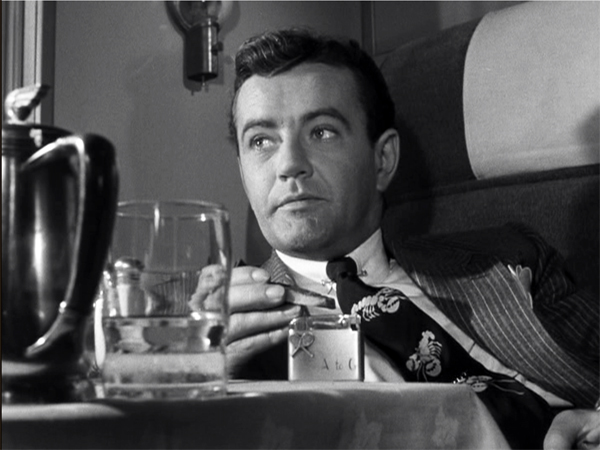
Most intrinsic norms aren’t laid out as boldly as the opening of A Man Escaped, but ingenious filmmakers may provide some variants. Take a fairly conventional piece of action in a suspense movie. A miscreant needs to plant evidence that incriminates some innocent soul.
In Strangers on a Train, that evidence is a cigarette lighter. Tennis star Guy Haines shares a meal with pampered sociopath Bruno Antony, whose tie sports colorful lobsters. Bruno steals Guy’s distinctive cigarette lighter.
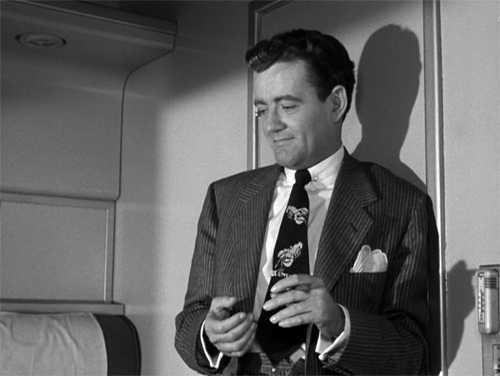 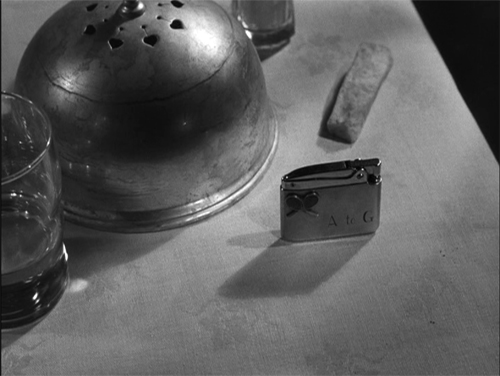
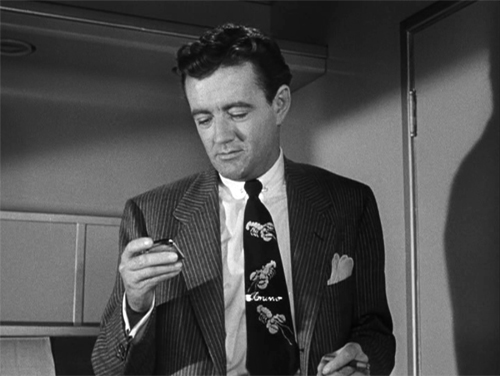
Bruno has proposed that they exchange murders: He will kill Guy’s wife Miriam, who’s resisting divorce, and Guy will kill Bruno’s father. Bruno cheerfully strangles Miriam at a carnival, aided by the lighter.
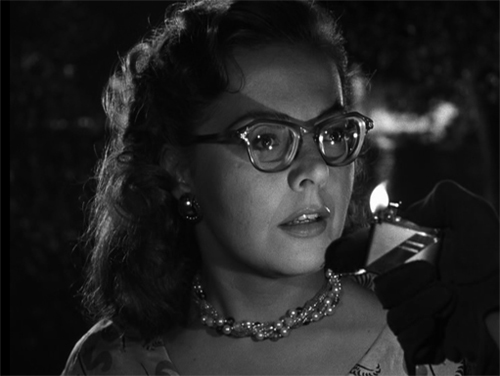
When Guy doesn’t go through with his side of the deal, Bruno resolves to return to the scene of Miriam’s death and leave the lighter to incriminate Guy. The film’s climax consists of the two men fighting on a merry-go-round gone berserk. Although Bruno dies asserting Guy’s guilt, the lighter is revealed in his hand. Guy is exonerated.
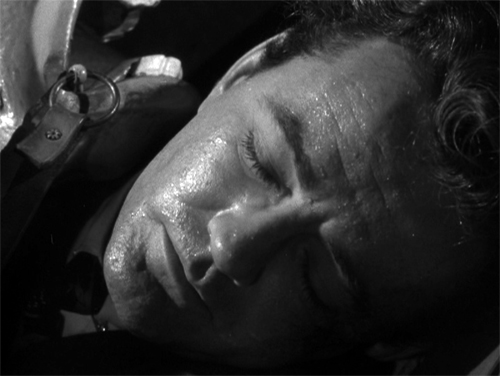 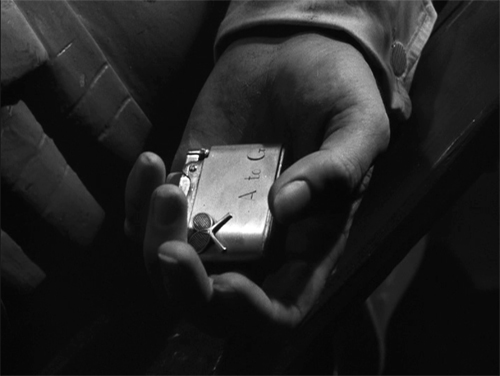
Once the lighter is introduced in the early scenes, it comes to dominate the last stretch of the film. In scene after scene, Hitchcock emphasizes Bruno’s possession of it. Sometimes it’s only mentioned in dialogue, but often we get a close-up of it as Bruno looks at it thoughtfully–here, brazenly, while Guy’s girlfriend Ann is calling on him.
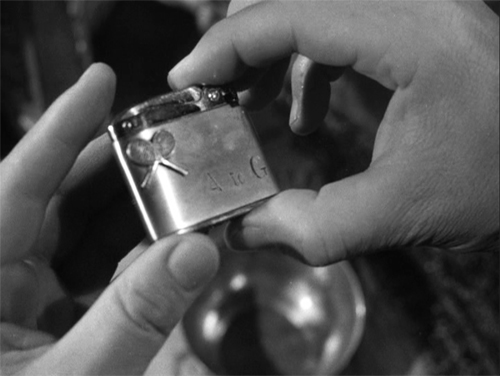 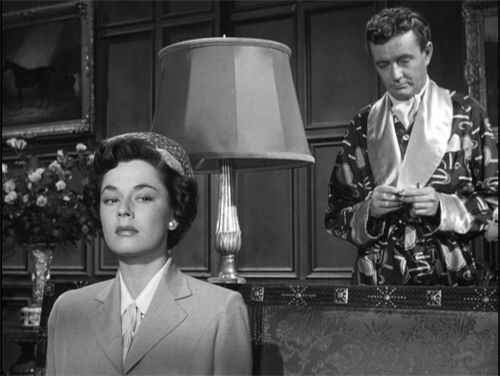
When Bruno picks up a cheroot or a cigarette, we expect to see the lighter.
One of the film’s most famous set-pieces involves Bruno straining to retrieve the lighter after it has fallen through a sidewalk grating.
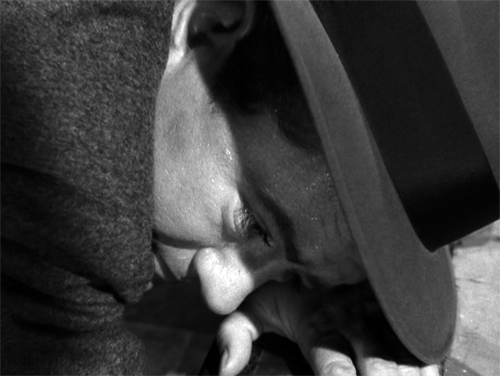 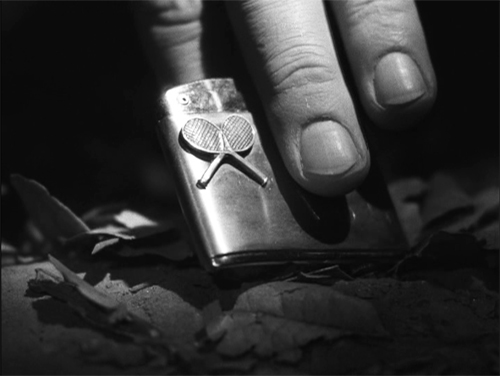
Bruno has dropped it before, during Miriam’s murder, but then he notices and retrieves it. It’s as if this error has shown him how he might frame Guy if necessary. The image of the lighter in the grass previews for us what he plans to do with it later.
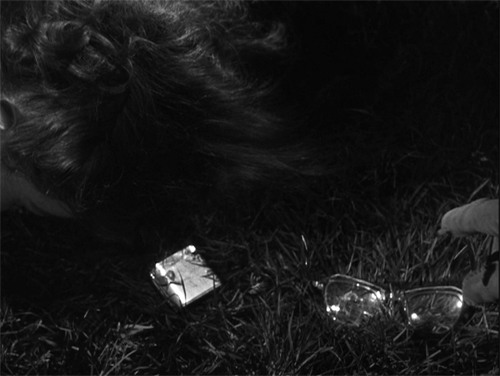 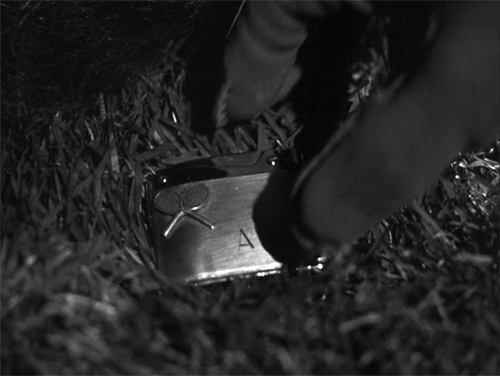
What does the lighter have to do with norms? Most obviously, Strangers on a Train teaches us to watch for its significance as a plot element. It’s not only a potential threat, but also Bruno’s intimate bond to Guy, as if Bruno has replaced Ann, who gave Guy the lighter. The film also invokes a normalized pattern of action–a character has an object he has stolen and will plant to make trouble–and treats it in a repeated pattern of visual narration. The character looks at the object; cut to the object; cut back to the character in possession of the object, waiting to use it at the right moment. Our ongoing understanding of the lighter depends on the norm-driven presentation of it.
Once we’re fully trained, Hitchcock no longer needs to show us the lighter at all. En route to the carnival to plant the lighter, Bruno lights a cigarette with the lighter, although his hands conceal it. But then the train passenger beside him asks for a light.
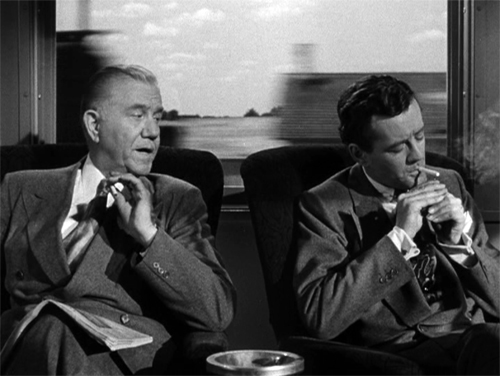
In order to hide the lighter, Bruno laboriously pockets it and fetches out a book of matches.
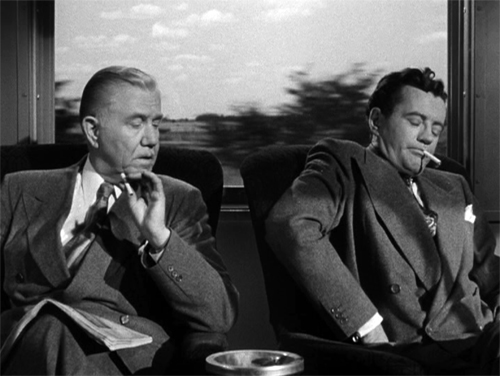 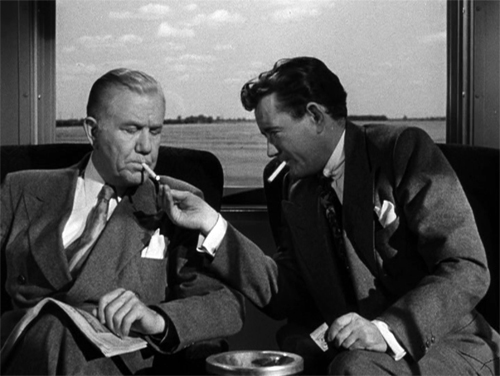
If we saw only this scene, we might not have realized what’s going on, but it comes long after the narrational norm has been established. We can fill out the pattern and make the right inference. Bruno wants no witness to see this lighter.
The hand that cradles the rock
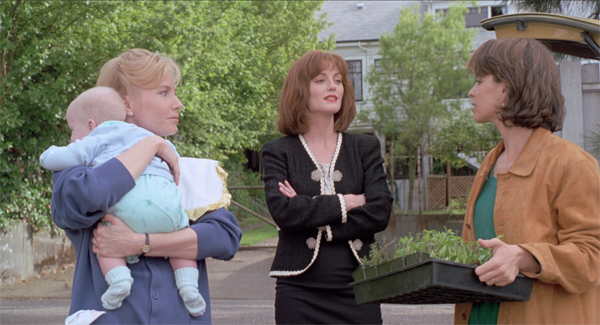
In The Hand That Rocks the Cradle, under the name Peyton Flanders, Mrs. Mott becomes nanny to Claire’s daughter and infant son. Pretending to be a friendly helper, she subverts Claire’s daily routines and her trusting relationship with Michael. As in most domestic thrillers, the accoutrements of upper-middle-class lifestyle–a baby monitor, a Fed Ex parcel, expensive cigarette lighters, asthma inhalers, wind chimes–get swept up in the suspense. Peyton weaponizes these conveniences, and through a somewhat unusual narrational norm the film trains us to give her almost magical powers.
We get Peyton’s early days in household filtered through her point of view. Classic POV cutting is activated during her job interview. She notices that Claire’s pin-like earring drops off and she hands it back to her.
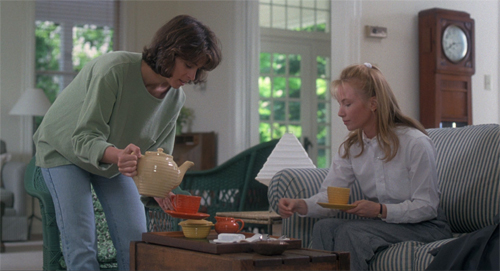 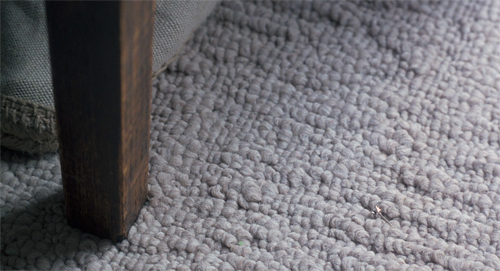

Attachment to Peyton gets more intense when she sees the baby monitor and then fixates on the baby.
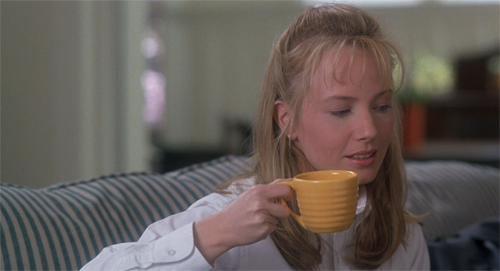 
 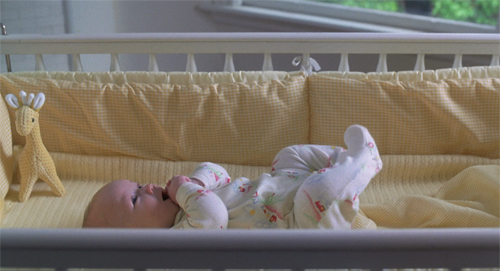
We’re then initiated into her tactics, and to the film’s way of presenting them. Serving supper, Claire doesn’t notice that her earring drops off again. Peyton does.
 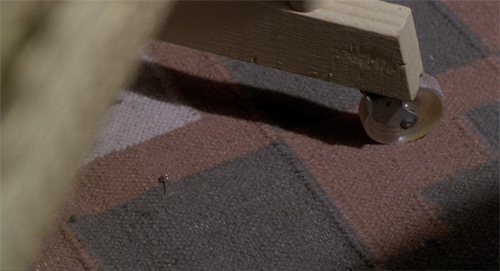
Breaking with her POV, the narration shifts to Claire and Michael talking about hiring her. But this cutaway to them has skipped over a crucial bit of action: Peyton has picked up the earring. Unlike Hitchcock, director Curtis Hanson doesn’t give us a close-up of the important object in the antagonist’s hand. In a long shot we simply see Peyton studying her fingers. Some of us will infer what she’s up to; the rest of us will have to wait for the payoff.
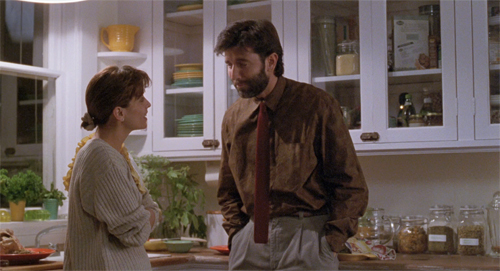 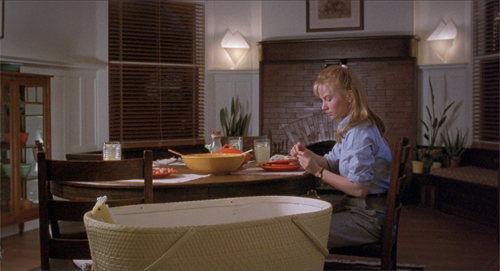
After another cutaway to the couple, Peyton “discovers” the earring in the baby’s crib. Her show of concern for his safety seals the hiring deal and begins her long campaign to prove that Claire is an unfit mother.
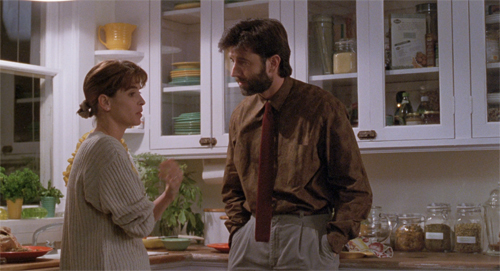 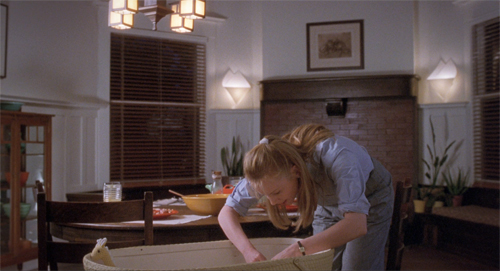
This elliptical presentation of Peyton’s subterfuges rules the middle section of the film. Selective POV shots suggest what she might do, but we aren’t shown her doing it–only the results. For instance, Claire lays out a red dress for a night out. Peyton sees it, then sees some perfume bottles.
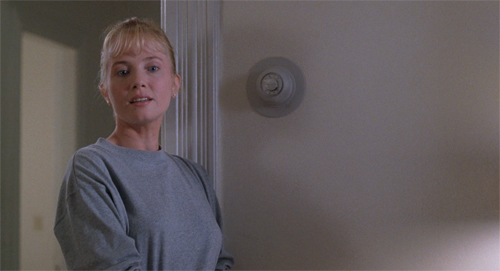 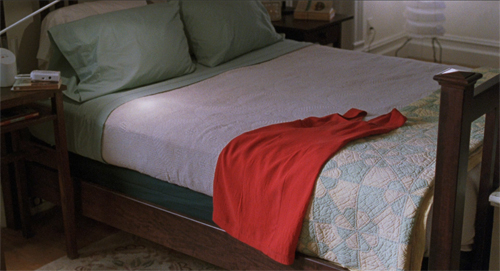
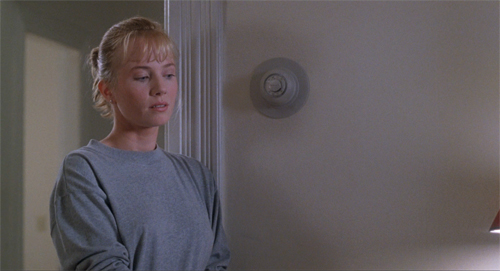 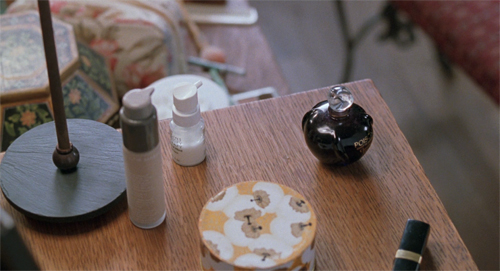
Cut to Claire and then to an arriving guest, and presto. When she returns to the mirror, her dress is suddenly revealed as having a stain.
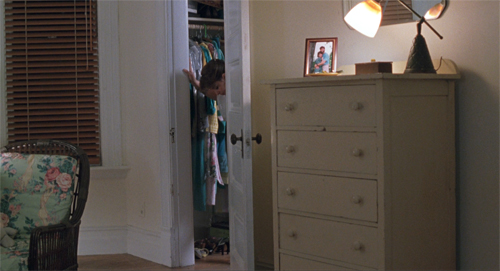 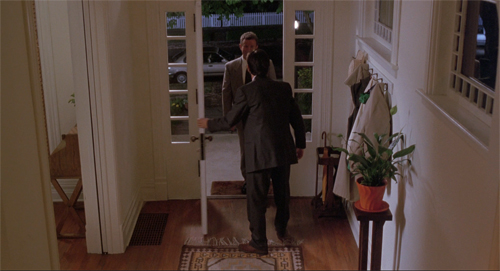
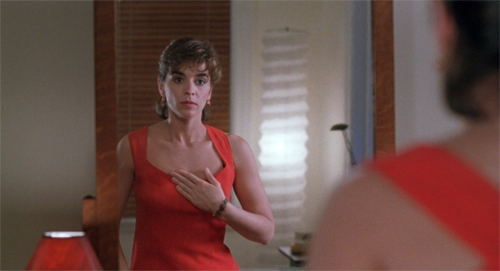
Later, Claire agrees to send off Michael’s grant application during her round of errands. Once she gets to the Fed Ex office, she will discover the missing envelope. Before that, though, we get another variant of the intrinsic norm showing Peyton’s trickery.
In the greenhouse, while Claire is watering plants, Peyton spots the envelope in her bag. We don’t see her take it, and there’s even a hint that she hasn’t done so. A nifty shot lets us glimpse her yanking her arm away as Claire approaches. It’s not clear that she has anything in her hand.
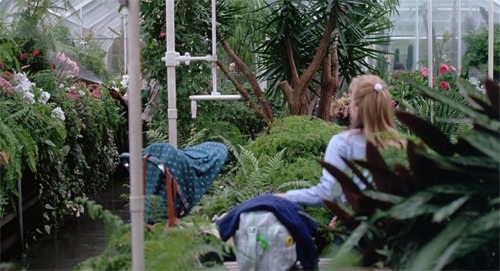 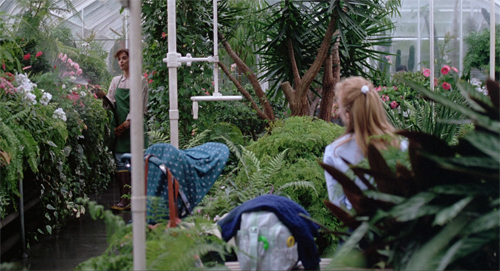
In what follows, the narration confirms Peyton’s theft while building up the threat level.
If she’s caught, this woman will not go away quietly.
While cozying up to the children–Peyton cuddles with Emma and even secretly breast-feeds baby Joe–Peyton eliminates all of Claire’s allies. By now we know her strategy, so after she suggests to Claire that the handyman Solomon has been molesting little Emma, all the narration needs is to show us Claire discovering a pair of Emma’s underwear in his toolbox. As with Bruno’s pocketing the lighter in Strangers on a Train, we’re now prepared to fill in even more of what’s not shown: here, Peyton framing Solomon.

Michael, a furtive smoker, sometimes shares a cigarette with Marlene. So it’s easy for Peyton to plant Marlene’s lighter in Michael’s sport coat for Claire to discover. Again, the moment of the theft has given her quasi-magical powers. She sees Marlene’s lighter in her handbag in the front seat.
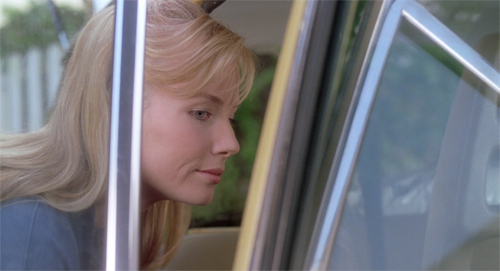 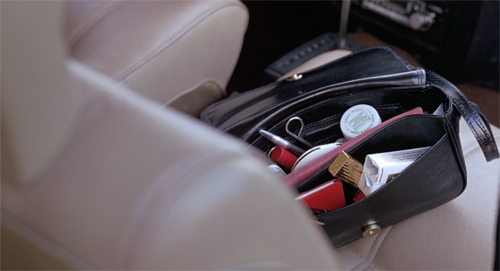
Again thanks to a cutaway, we don’t see her take it. Indeed, it’s hard to see how she could have; she comes out of the back seat with an armload of plants.
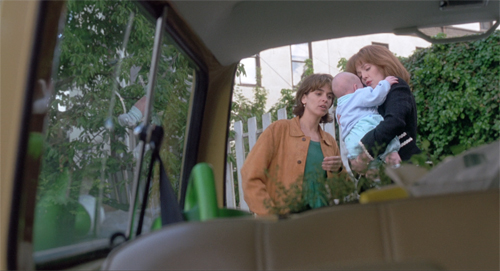 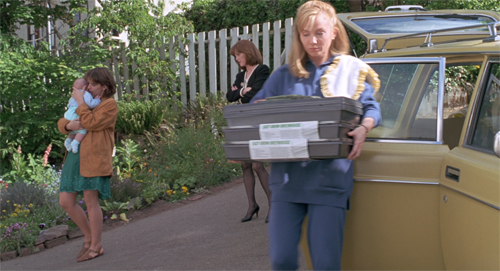
But later Marlene will tell Michael (i.e., us) that she’s lost her lighter, and a dry cleaner will find it and show it to Claire.
The attacks have escalated, with Claire now suspecting Michael of infidelity. She confronts him without knowing that Michael has invited friends to a surprise party for her. Her angry accusations are overheard by the guests, and this public display of her anxieties takes her to a new low.
Peyton’s revenge plan is almost wholly consummated, so we stop getting the elliptical POV treatment of her thefts. Instead, the plot shifts to investigations: first Marlene discovers Peyton’s real identity, with unhappy results, and at the climax Claire does. Her POV exploration of the empty Mott house counterbalances Peyton’s early probing of Claire’s household. When she sees Mrs. Ott’s breast pump–another domestic object now invested with dread–she realizes why baby Joe no longer wants her milk.
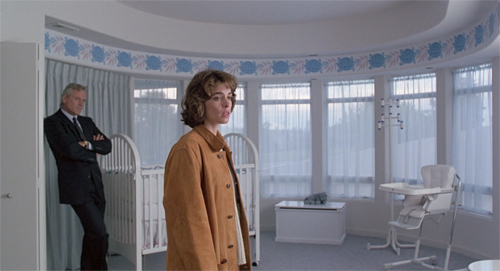 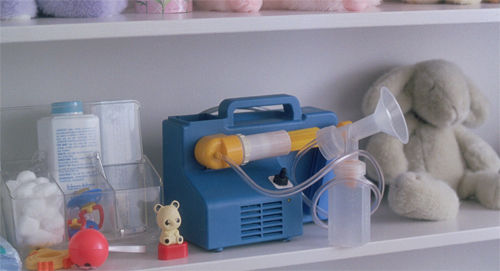
This is the point, fairly common in the thriller, when the targeted victim turns and fights back.
In The Hand That Rocks the Cradle, a familiar action scheme–someone swipes something and plants it elsewhere–is handled through an unusual narrational norm. The scenes showing Peyton’s pilfering skip a step, and they momentarily let us think like her, nuts though she is. Thanks to editing that deletes one stage of the standard shot pattern, the film trains us to see how banal domestic items, deployed as weapons, can destroy a family. In the course of learning this, maybe the movie makes us feel smart.
Arguably, we’re able to fill in the POV pattern in The Hand That Rocks the Cradle because we’ve learned from encounters with movies that used the standard action scheme, including Strangers on a Train. This is one reason film style has a history. Dissolves get replaced by fades, exposition becomes more roundabout, endings become more open. As audiences learn technical devices, intrinsic norms recast extrinsic ones and some movies become more elliptical, or ambiguous, or misleading. All I’d suggest is that we get accustomed to such changes because films teach us how to understand them. And we enjoy it.
The passage about training us comes from my Narration in the Fiction Film (University of Wisconsin Press, 1985), 45. I discuss norms in blog entries on Summer 85, on Moonrise Kingdom, on Nightmare Alley, and elsewhere. A book I’m finishing applies the concept to novels as well as films.
The example of mismatched reverse angles comes from The Irishman (2019) In the first cut, Frank is starting to settle his coat collar, but in the second, his arms are down and the collar is smooth. In a later portion of that second shot, Hoffa gestures freely with his right hand, but in the over-the-shoulder reverse, his arm is at his side and it’s Frank who gets to make a similar gesture. To be fair, I should say that I found some striking reverse-angle mismatches in Strangers on a Train too.
For more on conventions of the domestic thriller, go to the essay “Murder Culture.”
Radomir D. Kokeš offers an analysis of how Kristin and I have used the concept of norm. We are grateful for his careful discussion of our work and his exposition of the achievement of literary theorist Jan Mukarovský. See “Norms, Forms and Roles: Notes on the Concept of Norm (not just) in Neoformalist Poetics of Cinema,” in Panoptikum (December 2019), available here.

Strangers on a Train (1951).
Posted in Directors: Hitchcock, Directors: Scorsese, Directors: Tarantino, Film comments, Film criticism, Film genres, Film technique, Film technique: Editing, Film theory, Narrative strategies |  open printable version
| Comments Off on Learning to watch a film, while watching a film open printable version
| Comments Off on Learning to watch a film, while watching a film
Sunday | June 20, 2021
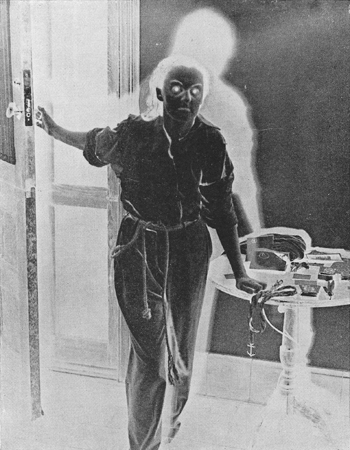 
The Castle Island Case (1937).
DB here:
In the 1920s and 1930s, stories of mystery and detection became hugely popular in Anglophone countries. Britain’s “Golden Age” of whodunits, launched by Agatha Christie and Dorothy Sayers, was rivaled by the emergence of American hardboiled detection, personified by Dashiell Hammett and other writers for the pulp Black Mask. Some of the detectives, such as Philo Vance and (alas) Ellery Queen, are largely forgotten today, but others remain towering figures of popular culture. Surprisingly, new Sherlock Holmes stories were still appearing in the 1920s. In addition, there emerged Hercule Poirot, Lord Peter Wimsey, Charlie Chan, Sam Spade, Nick and Nora Charles, Nero Wolfe, Philip Marlowe, and Perry Mason (recently revised in a noir version for streaming). Fiction, film, comic strips, and radio all disseminated their adventures. Nancy Drew and the Hardy Boys were aimed at the kids.
Amid this vast 0utput, writers needed to differentiate their work. The search for gimmicks was on, and a few were, as we’d say now, a little interactive. Since the classic detective plots centered on puzzles, publishers added games and playful ancillaries to their books.
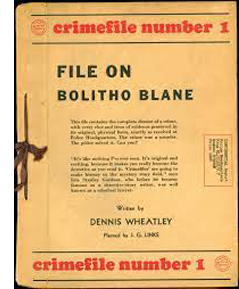 Some novels were published with the last chapters sealed, daring buyers to resist curiosity and return the book for a refund. A novel (The Long Green Gaze, 1925) might tuck clues into crossword puzzles (another 1920s fad) that the reader had to solve. Books came packaged with jigsaw puzzles (The Jig-Saw Puzzle Murder, 1933; Murder of the Only Witness, 1934). “Murder dossiers” like File on Bolitho Blane (aka Murder in Miami, 1936) assembled facsimile documents accompanied by matchsticks, strands of hair, bloodstained scraps of fabric, and other physical clues. The party game of Murder, in which guests were assigned roles of victim, culprit, witnesses, and detectives, became a craze and was, naturally, incorporated into novels (Hide in the Dark, 1929). Some novels were published with the last chapters sealed, daring buyers to resist curiosity and return the book for a refund. A novel (The Long Green Gaze, 1925) might tuck clues into crossword puzzles (another 1920s fad) that the reader had to solve. Books came packaged with jigsaw puzzles (The Jig-Saw Puzzle Murder, 1933; Murder of the Only Witness, 1934). “Murder dossiers” like File on Bolitho Blane (aka Murder in Miami, 1936) assembled facsimile documents accompanied by matchsticks, strands of hair, bloodstained scraps of fabric, and other physical clues. The party game of Murder, in which guests were assigned roles of victim, culprit, witnesses, and detectives, became a craze and was, naturally, incorporated into novels (Hide in the Dark, 1929).
The most outrageous of these extramural activities was Cain’s Jawbone (1934). The 100-page story purports to be a mystery novel whose whose pages were accidentally printed and bound out of order. There is, the reader is assured, only one correct sequence, although “the narrator’s mind may flit occasionally backwards and forwards in the modern manner.” The publisher offered a prize to the first reader who could submit the correct ordering–and, not incidentally, name both the murderer(s) and the victim(s). Only two people hit on the answer, which still remains unknown to the public.
Even quite well-known writers joined in. The original editions of Sayers’ Five Red Herrings (1931) left a page blank so that the reader could jot down a guess at what Lord Peter asked the police to find at the murder scene. Sayers was quite proud of “this little stunt,” and floated the possibility of printing the missing passage in a sealed page at the end of the book. She also wrote a Lord Peter story that invited the reader to solve a rather recondite crossword. Q. Patrick composed a murder dossier, The File on Claudia Cragge (1938).
Less immersive but still pretty interesting was my topic of today. I think it coaxes us to think about how pictures and text can interact, and how a book can borrow film techniques. In addition, it has enough weird touches to make it a remnant of a period in desperate search of storytelling novelty. You know, like ours.
More highly seasoned than most
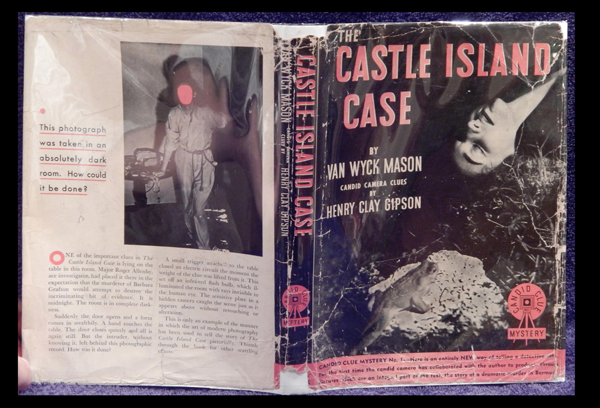
With The Castle Island Case (published September 1937) a fairly famous author, Van Wyck Mason, introduced what he considered “a brand-new method of telling a mystery story.” That method involved accompanying the novel with staged photographs of the characters, clues, and crime scenes. Mason insisted that he and photographer Henry Clay Gipson came up with the idea before the first murder dossier (1936) and before Look magazine’s “Photocrime” series, which began running in June of 1937.
Novels had long been illustrated; our undying conception of Holmes owes a good deal to Sidney Paget’s vivid drawings in the original stories. And comic books, which had begun telling long-form stories in the 1930s, showed that pictures (helped out by verbiage) could sustain plots. But photography changes the status of the image. Mason believed that photos could be not “mere illustrations but an essential, integral part” of the novel.
Interestingly, he doesn’t rest his case on realism, the idea that the story would seem more plausible if it contained documentary images. But surely the appearance of a photographic record gives a forensic quality to the shots of clues and corpses. At the period, tabloids and even “family” magazines like Life and Look were incorporating gory crime-scene images.
In The Castle Island Case, as befits fiction, these are more artfully composed. The shots of Allenby at an autopsy and of a topless woman washed onto the beach, we’re told, “were a very definite part of the story and were not included merely for effect.”
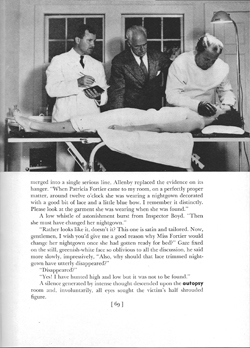 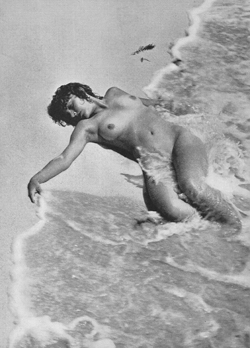
Still, they are a bit startling in their prim sensationalism. (One reviewer: “A thriller more highly seasoned than most.”) The book’s up-and-coming publisher, Reynald & Hitchcock, had developed a reputation for daring: it published Hitler’s Mein Kampf in a complete translation the same year as Mason’s novel. Later the firm would issue policy books from a liberal standpoint and, in 1944, the controversial Lillian Smith novel Strange Fruit.
For the shoot Reynald & Hitchcock flew the cast to Bermuda, where Mason lived. The story incorporated the exotic scenery and local life, notably a Gombey performance. Mason and Gipson accumulated about 600 stills in ten days, and they checked their results immediately, processing films far into the night. The finished book includes 180 or so shots, printed alongside text on glossy paper and bound in a large 7½ x 10-inch trim size that make them easy to study. An essential hook, trumpeted on the dust jacket, is that you can examine the pictures to find evidence that the text doesn’t mention. This was to be the first in a series of “Candid Clue Mysteries”–crime traces captured by the candid camera.
Picture this
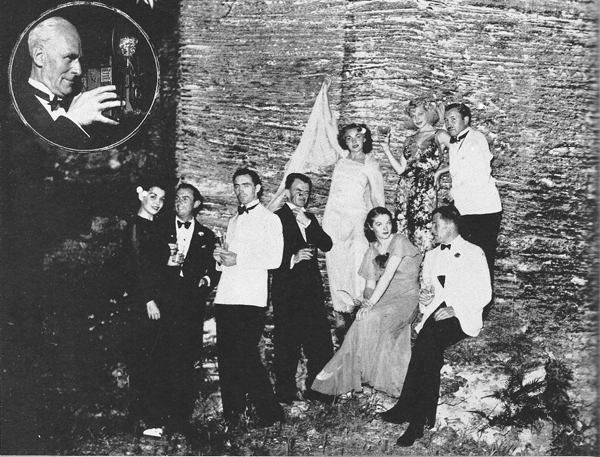
Major Roger Allenby has flown to Bermuda to help an old friend whose daughter Judy has gone missing. She was serving as secretary to millionaire Barnard Grafton. Allenby arrives under the pretext of joining Grafton’s shady business deal with the president of Ecuador. Grafton is hosting other potential investors and several female guests. The set-up is a classic mystery situation: an isolated setting and a small group of wealthy people, some of whom will die or disappear, leaving the others as suspects. Soon Judy’s sister Patricia, who has replaced her on Grafton’s staff, is murdered.
The photos are of three types. One operates as classic illustrations, showing all the characters from an impersonal perspective. So Allenby can be seen among others, as in the rather Straub/Huilletian autopsy image above. A second type of images is more “omniscient” and free-ranging, filling us in on background information.
Mason declared that the photos could save time on exposition. Instead of describing the characters and settings, he could just show them. But he didn’t mention that, apart from Allenby, most major characters are introduced in abstract photomontages, not candid snapshots. The first one we see is devoted to wastrel C. Townley Ward. He’s presented in a collage of pictures and news clippings.

The page devoted to Ward could have been replaced with paragraphs of backstory. But the layout coaxes the reader into a process of scrutiny that’s probably more intense than scanning prose. Are there clues in the images or the clippings? This crammed page, coming early in the book, encourages the reader to look carefully at the pictures that follow. This attention wouldn’t necessarily be aroused by traditional drawn or painted illustrations.
Sometimes, as in the page devoted to jaunty Kathleen Manship, the layout recalls comic-book splash pages.
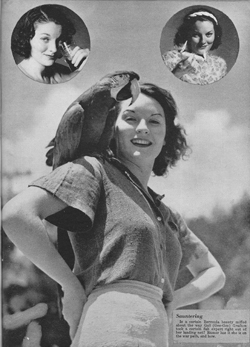 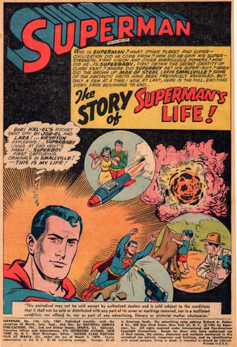
A second sort of photos accords with Allenby’s restricted viewpoint. He has brought his camera along, so some images, like the nude shot on the beach, are represented as his recording of a crime scene.
Naturally Allenby films letters and other obvious clues, and he sets traps to gain evidence. He rigs up an automatic camera device to capture an intruder, but to sustain suspense Mason shows us the negative first, then postpones revealing the person exposed (as above).
Sometimes, though, it’s Allenby’s casual snapshots that accidentally capture items whose significance is apparent later. In all, Mason tries to play fair with the reader. If you page back after the solution is revealed, you can find that indeed the clue was there (however tiny). In good mystery-mongering fashion, however, some pages are red herrings. They contain no clues, but you’re likely to study them anyhow.
Photography also helps us grasp clues that are more vivid than a prose description could provide. My favorite is the telltale pack of playing cards left behind by Patricia after her death. Trying them out in different sequences, Allenby notices that they contain tiny nicks on their edges. Odd phrases in Judy’s purported suicide note suggest a code the sisters shared, so after cracking that and arranging the cards accordingly, Allenby finds that the nicks yield a message.
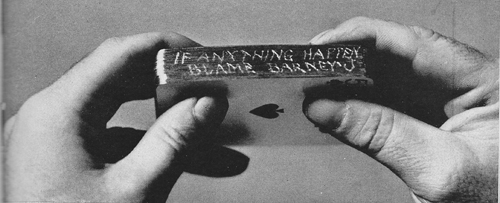
I think that the picture makes the discovery livelier than an account in the text would be.
As in many detective stories, the clues are summed up before the detective reveals the solution. Here, Mason gathers up the most relevant photos Allenby has taken, challenging the reader to draw the right conclusions.
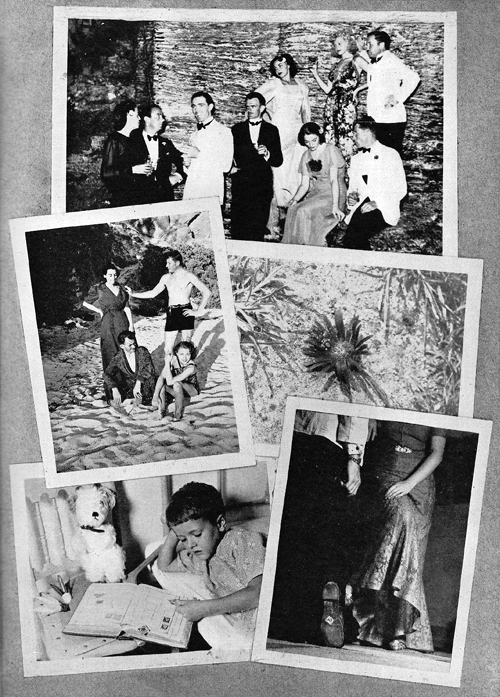
Another plot convention: the final assembly of the suspects for a public revelation of guilt. In this book, it’s done through Allenby’s setting a trap. He will take an infrared picture that will, during a crucial moment of darkness, expose the killer. The exercise neatly brings together the objective, omniscient type of photo and Allenby’s eyewitness shots. First we see the entire scene, including Allenby. Then his camera’s record is presented in radically washed-out tones, suggesting a different film stock. (The second frame below is a detail from the climactic two-page spread, to avoid a spoiler.)
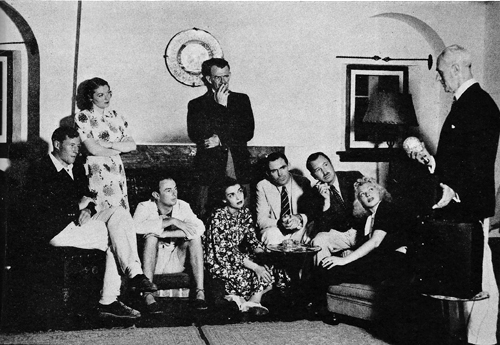
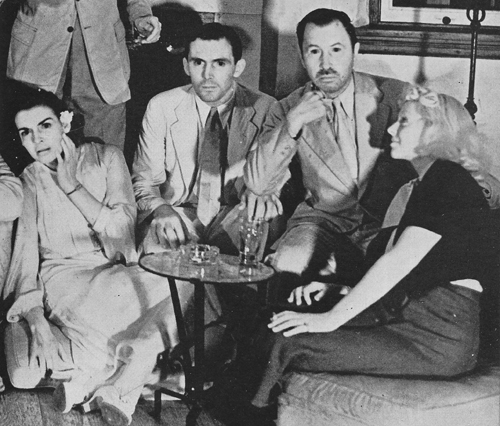
Movies on the page

The gimmickry of The Castle Island Case is enlivened by some features that go beyond puzzle and fair play. The book breaks its own rules, sometimes in ways that recall films. For example, we get a cluster of reaction shots of the characters responding to news of Patricia’s death.
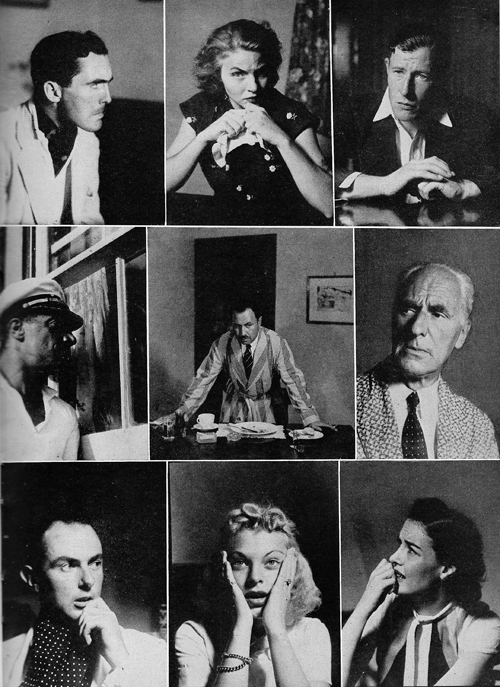
The pictorial narration running alongside the text sometimes breaks from our restriction to Allenby’s viewpoint for the sake of a cinematic effect. As he broods on the danger Patricia is in, the book “cuts away” to her in her bedroom. Four images show her sorting the playing cards, slipping the suicide note into a picture frame displaying her sister’s photo, tucking the pack of cards under her pillow, and–ultimate movie touch–sleeping while a clutching shadow hovers over her.
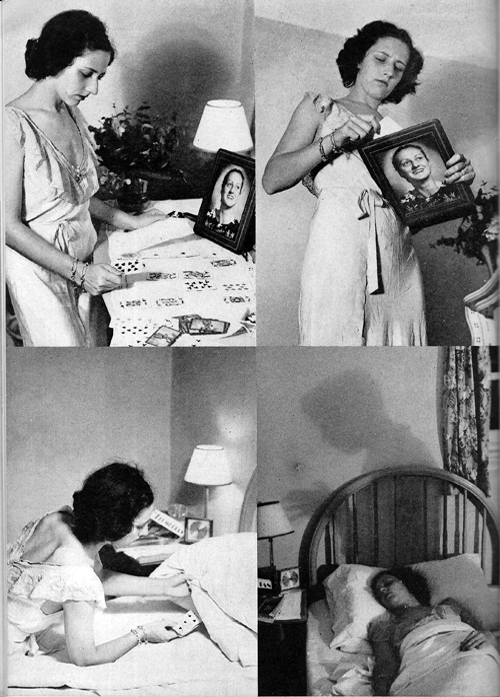
Still later, the book will present a pictorial flashback, complete with angle changes, to show what led to Judy’s disappearance. There’s also a photomontage illustrating Terry James’ freewheeling lifestyle that calls to mind the turbulent montage sequences of Slavko Vorkapich.
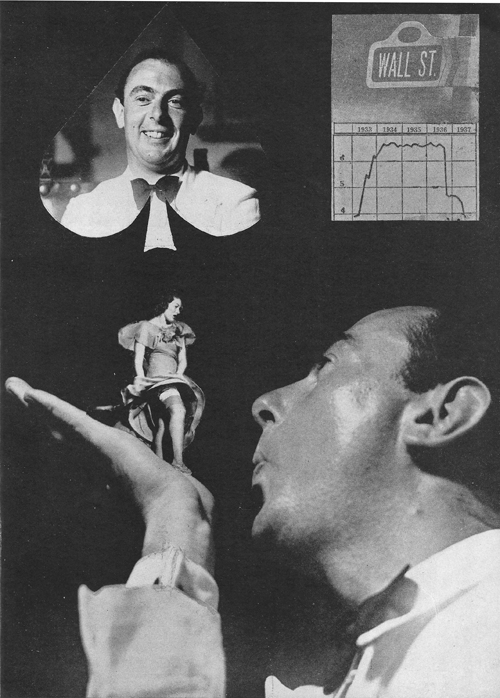
The book’s debt to cinema is perhaps most obvious in its last image, a clinch that traditionally closes a Hollywood movie. (See below.) Far stranger is the sequence devoted to the drinks-and-swims party.
One page presents the guests hanging out, with the bottom one suggesting a party snapshot not taken by Allenby, although he’s in it.
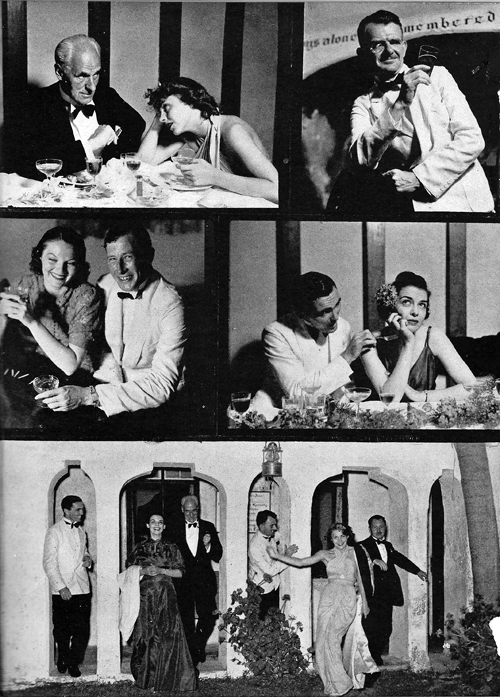
Facing this page is a curious portrait, evidently not taken by Allenby, showing a morose Grafton staring into his drink.

What’s he looking at? Inside the champagne glass is the head of an apparently drowning woman.
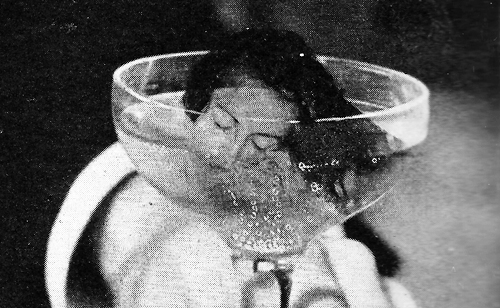
Is this a tipoff to the reader that Grafton killed Patricia? At the end we’ll realize what it means, but here it seems to offer a peculiar access to his mind, certainly beyond Allenby’s range of knowledge. In a film, the image might be an abrupt, enigmatic flashback to be explained later. Frozen on the page, and looking so different from the other photos we’ve seen, this hallucination turns into kitsch surrealism.
Nothing ever really goes away. Perhaps the murder dossiers transmogrified during the 1940s into the board game Clue (aka Cluedo). The Wheatley ones were reprinted in the 1980s and apparently caught on for a new generation. The Choose Your Own Adventure children’s books included mysteries that allowed some interactivity, anticipating the branching options of our investigation-driven videogames. And today’s jigsaw puzzle called Alfred Hitchcock is explained:
Alfred Hitchcock isn’t just another jigsaw puzzle – it’s a mystery waiting to be solved. First, read about a psychotic fan who’s obsessed with Hitchcock’s classic films. Next, assemble the puzzle and uncover hidden clues to solve the mystery.
 Mason’s “Candid Clue Mystery No. 1” had no successors, but writers didn’t give up on trying to integrate images into mystery plots. Rex Stout tried it, with awkward results, in two Nero Wolfe stories. (One, naturally enough, appeared in Look magazine.) In Murder Draws a Line (1940), Willetta Ann Barber and R. F. Schabelitz divide the labor between a Nick-and-Nora couple. The wife writes the text and the husband, a professional artist, illustrates it with sketches and diagrams of their efforts to solve the crime. Mason’s “Candid Clue Mystery No. 1” had no successors, but writers didn’t give up on trying to integrate images into mystery plots. Rex Stout tried it, with awkward results, in two Nero Wolfe stories. (One, naturally enough, appeared in Look magazine.) In Murder Draws a Line (1940), Willetta Ann Barber and R. F. Schabelitz divide the labor between a Nick-and-Nora couple. The wife writes the text and the husband, a professional artist, illustrates it with sketches and diagrams of their efforts to solve the crime.
The text-plus-photos books aren’t truly interactive. Nothing we do can adjust the text or create feedback. But they extend the possibilities of a narrative attitude encouraged by the mystery genre.
Classic detective novels and short stories rely on a type of close reading. We’re expected to scrutinize descriptions of locales and behavior for cleverly planted traces of what’s really going on. Agatha Christie has a genius for mentioning items that we read over, thanks to misdirection and the blandness of her prose, but even hardboiled novels bury verbal clues so as to play fair. A slip of the tongue that we probably miss leads Sam Spade to Bridgid O’Shaughnessy’s guilt.
Knowing that authors aim to mislead us through language, we read with a greater degree of suspicion than we bring to other genres. By extending this attitude to images as well as words, gimmicks like The Castle Island Case encourage us to consider how the pictures may tell the story, or sabotage our understanding of it. That’s what movies have done as well. We shouldn’t be surprised that these oddball efforts call on familiar storytelling schemas of classical cinema.
Chapter 17 of Martin Edwards’ splendid The Life of Crime: Unravelling the History of Fiction’s Favorite Genre, reviews many more of these Golden Age games. It’s due out from Collins in May of next year, but in the meantime visit Martin’s bountiful website and proceed to sample any of his vast output of novels, anthologies, and histories of detective fiction.
For background on Cain’s Jawbone, go to this account in The Guardian. It was reissued in 2019, as both a book and a set of cards (now very scarce). The publisher, appropriately called Unbound, offered a prize of £1000 for the first solution. The prize was won by a comedy writer who cracked the puzzle while housebound during the Covid-19 pandemic.
Dorothy Sayers’ remark on her Five Red Herrings ploy comes from Janet Hitchman, Such a Strange Lady: A Biography of Dorothy L. Sayers (New York: Avon, 1976), 88-89. The Sayers story using a (very tough) crossword puzzle is “The Fascinating Problem of Uncle Meleager’s Will” (1925).
My quotations from Van Wyck Mason come from “The Camera as a Literary Element,” The Writer 51, 11 (November 1938), 325-326. The review I quoted, unsigned, appeared in “The Criminal Record,” The Saturday Review (9 October 1957), 28.
The Rex Stout Nero Wolfe stories inserting photographs are Where There’s a Will (1940) and “Easter Parade” (1957), reprinted in And Four to Go (1958). I don’t talk about them here.
Thanks to Peter McDonald for introducing me to Virginia, The Shivah, Blackwell Unbound, and other mystery-driven videogames.
P.S. 25 June 2021: Alert reader and old friend Jonathan Kuntz reminded me of other interactive mystery platforms, including the Secret Cinema screenings. He also mentions non-mystery boardgames that let you replay films, as in The Thing and The Lord of the Rings.
P.P.S. 28 June: Alert reader and mystery maestro Mike Grost traces a chain of association to the champagne-glass image. Van Wyck Mason published a story called “The Enemy’s Goal” in Argosy (18 May, 1935). That story was adapted by Joseph H. Lewis for a film, The Spy Ring, released in 1938, and there a character summons up a mental image in a champagne glass. I haven’t seen the film, but Mike suggests that such subjective shots are fairly rare in Lewis films. He thanks Francis M. Nevins for finding the link, and I thank both.
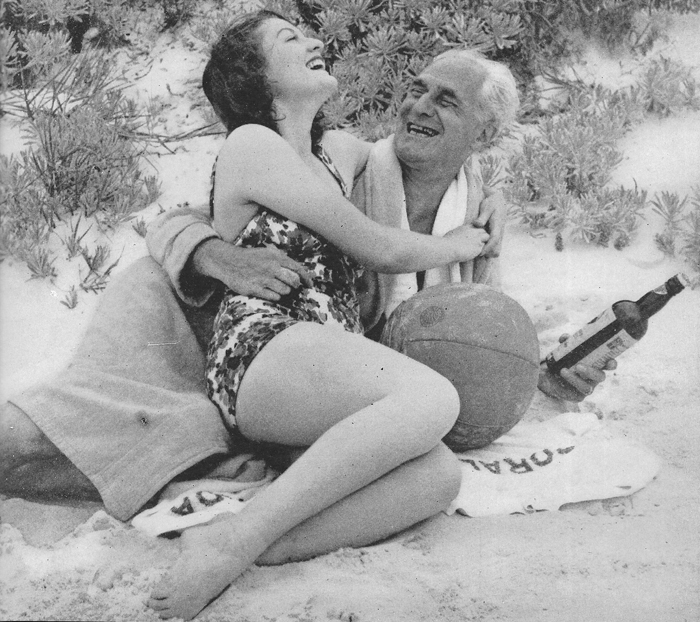
The Castle Island Case (detail).
Posted in Books, Film and other media, Film comments |  open printable version
| Comments Off on What you see is what you guess open printable version
| Comments Off on What you see is what you guess
Sunday | June 13, 2021
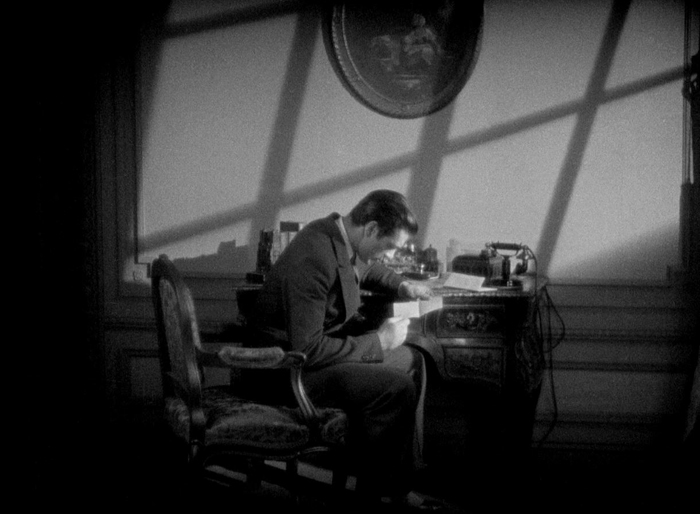
Children of Divorce (1927)
Kristin here:
In 2008, David and I attended Il Cinema Ritrovato for the sixth time. The Hollywood director being featured that year was Josef von Sternberg. We saw some of the gorgeous prints on show, most notably (for me), a chance to re-watch the underrated Thunderbolt (1929), his first sound feature. To us the big auteur of the year, however, was Lev Kuleshov. Astonishingly, we only blogged from the festival once that year. It was a busy summer.
We and a great many other festival-goers lined up to see one of the rarer items on the program: Children of Divorce, credited to Frank Lloyd but with reportedly about half the footage re-shot anonymously by von Sternberg. We and a considerable number of those festival-goers did not get into the auditorium. For some reason this rare, legendary film was shown in the smallest venue, the Mastroianni, which was packed, with the two side aisles full of standees. (See the bottom image of our blog from the festival, as we caught a glimpse of those lucky enough to get in before retreating to find something else to watch or perhaps to wander around the always enticing Film Book Fair.)
Eight years later, in 2016, Flicker Alley released a Blu-ray/DVD combo of the Library of Congress’ 4K restoration of Children of Divorce. That two-disc set is out of print, but last month a MOD (manufacture-on-demand) version was made available. It is a single disc, Blu-ray only, and its main supplement is a pretty good one-hour documentary on Clara Bow produced in 1999 for TCM. (The original booklet is not included.) Somehow we missed the original release, but now I have a chance to catch up with this elusive film.
Naturally I wanted to find out if any information on which scenes of the film von Sternberg re-shot were available, I looked at various internet sources, including books in our library the reviews of the original 2016 Flicker Alley release and books. I found nothing on the subject, not even from film buffs speculating on the basis of style which scenes were his. I suppose one reason why so little discussion of von Sternberg’s contribution is that for many viewers and purchasers of the Flicker Alley discs, this a Clara Bow and Gary Cooper film. Those online reviews from 2016 focus on them rather than on the two very different directors of Children of Divorce. The third star, Esther Ralston is excellent as Jean, and in 1929 she would go on to play the title character in The Case of Lena Smith, Sternberg’s last silent film, which survives only in a fragment. Still, she doesn’t have the lingering reputation and devoted following that her co-stars still enjoy.
Spoilers ahead, including a revelation of the ending.
Von Sternberg’s account
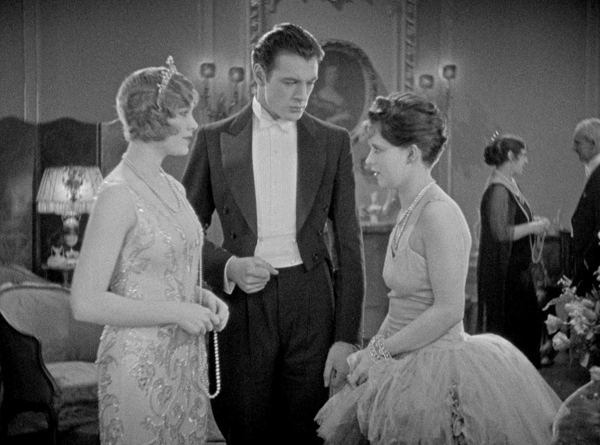
In trying to discover von Sternberg’s contribution, we seem to be entirely dependent on von Sternberg’s sketchy recollections of his work on the film in his memoir, Fun in a Chinese Laundry (1965). Needless to say, one cannot take his account as the unvarnished truth, but it may contain some elements of that commodity.
According to von Sternberg, B. P. Schulberg, head of Paramount, asked him to watch a film that the studio considered unreleasable. Could von Sternberg could improve it by adding the sort of clever intertitles that he was then known for?
I looked at the film as he requested. Its title was Children of Divorce, and it had been made by a prominent director, Frank Lloyd, normally an effective director of commercial films. This one was a sad affair, containing theatricals by Gary Cooper and Clara Bow, the “It” girl of her day. I reported back to the executive who had backed this venture with a million dollars, and told him that no skill of mine could restore life to the film by injecting text into the mouths of the players. I suggested that half the film be remade.
That Lloyd should fall down so badly seems odd, given that he had been cranking out films at a rapid pace since 1915. These included films that would be considered star vehicles and adaptations of popular literature, such as the first version of The Sea Hawk in 1924. He would soon go on to win two early best-director Oscars, one for the Greta Garbo vehicle The Divine Woman (1928) and one for Cavalcade (1933), as well as being nominated for what is probably his best-known film, Mutiny on the Bounty (1935)–which won Best Picture despite not winning any other of its seven other nominated categories. Cavalcade often shows up on lists of the worst films ever to won the highest prize, but nevertheless, it seems odd that a director so respected within the industry that he won an Oscar for a film made the year following Children of Divorce‘s release should fall down so badly in creating the latter. We shall probably never know what cause this strange failure.
I must admit to never having seen a Frank Lloyd film, but von Sternberg’s assessment of him as an “effective director” seems lukewarm. It suggests that although Lloyd was a good, solid Hollywood practitioner, he had created an unwonted lemon.
In assessing the verity of von Sternberg’s account, we should pause over von Sternberg’s claim that Children of Divorce had had a million-dollar budget. That was well above the average cost of a film in those days. (Von Stroheim’s Foolish Wives, with its giant Monte-Carlo set, had gone over budget to become the first million-dollar film in 1922, and Universal head Carl Laemmle made the best of the situation by blazoning the extravagant budget in publicity for the film.) The original costs estimate sheet on Flicker Alley’s site, along with other documents from the film’s production, puts the total budget at $334,000–pre-re-shoots–a far more plausible sum. Possibly, writing in the wake of the scandal over the cost overruns leading to an estimated $44 million budge for Cleopatra (1963), he had to boost the paltry-sounding budget of a late-1920s feature at least to seven figures to show that he was doing an important favor for Schulberg.
In response to von Sternberg’s suggestion that half the film be remade, Schulberg (according to von Sternberg) said that he could not allot another five weeks to making changes in a project that still might flop. Von Sternberg writes, “I carelessly replied that I could remake half the film in three days and turn over a successful version to him.”
Schulberg asked, “What can I do about the sets? They’ve been torn down and the stages are full.”
Again according to von Sternberg, “I told him to have a tent erected for use as a stage and to dig out the sets from storage, and not to bother about anything else.” Schulberg agreed.
Von Sternberg’s entire account of the process of re-shooting the scenes runs as follows:
The tent went up and the transfusion began. A rainstorm came and lasted three days and three nights. We waded through the new scenes, now and then dodging a heavy burst of water that penetrated the canvas overhead. The crew that helped me and the poor actors that I mercilessly put through their new paces had to take a prolonged rest cure when I had finished with them. To match the scenes I wished to retain I had to use the style of the replaced director. The assignment was completed on time and, after removing the old scenes and replacing them with the new material, I showed the film to the flabbergasted executives.
This tells us discouragingly little. The weather and the cast’s exhaustion make for a dramatic tale but tell us nothing about the film itself. The only statement of interest is “To match the scenes I wished to retain I had to use the style of the replaced director.” Von Sternberg certainly knew the well-established norms of Hollywood filmmaking and if he deliberately set to blend his work into an existing film, his style could be difficult to detect. After all, we don’t know exactly what was wrong with the original version. Bad performances? Von Sternberg’s reference to “theatricals by Gary Cooper and Clara Bow” suggests that this may have been the case. Bad storytelling? Von Sternberg doesn’t mention whether he re-wrote any of the scenes he revised.
The new version premiered on April 2, 1927. Von Sternberg was not paid for his labors (he says), but he did prove himself as a director. Schulberg allowed him to direct an entire feature himself. Later that year, on August 20, his first silent masterpiece, Underworld, came out. This item in Variety of March, 1927, seems to confirm the basic claim of von Sternberg’s account. Several trade papers mentioned that Sternberg had re-shot some scenes, but none specifies which ones.
Briefly, Children of Divorce concerns two girls whose recently divorced parents have dumped them in a convenient French convent to be cared for. The parents return to the free life of single people, visiting their daughters infrequently. Kitty, a frightened, lonely girl, befriends the kindly Jean. Kitty introduces Jean to Teddy, an old neighbor of Kitty’s. Teddy and Jean hit it off and promise to marry as adults.
Kitty grows up and becomes Clara Bow. She is poor and must give up her love for the noble but impoverished Prince Ludovico (Einar Hansen) to pursue Teddy, now grown up to be Gary Cooper and very rich. His meeting with the grown-up Jean (Esther Ralston), herself now described as the richest woman in the USA, rekindles their love. Despite knowing this, Kitty uses the occasion of a drunken party to trick Teddy into marrying her, and they have a daughter.
Teddy wants to divorce Kitty and marry Jean, but insists that the daughter must not be as they were, a child of divorce. Kitty thinks this would free her to marry Ludo, but he informs her that his religion would not permit him to marry a divorced woman. She determines to hold onto Teddy. Jean decides to marry Ludo, thus quashing Teddy’s hopes of marrying her. Pure misery abounds–all the result, one way or another, of divorce.
What did von Sternberg do?
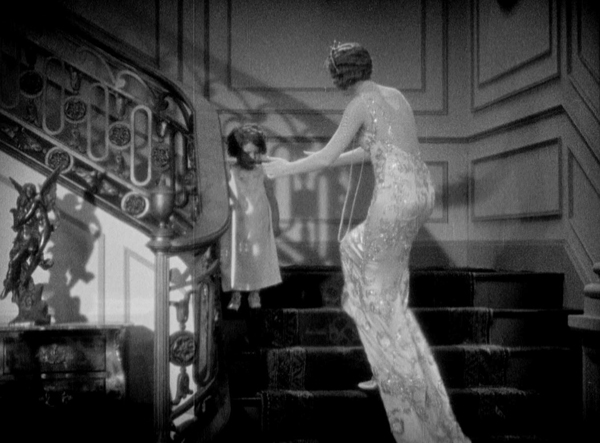
Naturally one would wish to know which scenes are Lloyd’s and which Sternberg’s. In her brief program notes for the film in the Bologna catalogue, Janet Bergstrom confidently comments, “You can’t miss the shadow language of his scenes.” Perhaps not, but there are actually very few Sternbergian shadowy shots in the film, and those are often brief touches. Here are the main examples. The second scene of the film shows the young Kitty (later to grow into Clara Bow) during her first night in the French convent where her newly divorced mother has dumped her (bottom). In another such atmospheric shot, Teddy reads Jean’s letter refusing to marry him if he divorces Kitty (top).
Other such shots occur occasionally. When Teddy and Kitty’s daughter totters winsomely down the stairs during a party, the elaborate railing casts a shadow over her. Jean’s first sight of her fixes her determination that for the sake of the child she will not agree to marry Teddy if he divorces Kitty.
 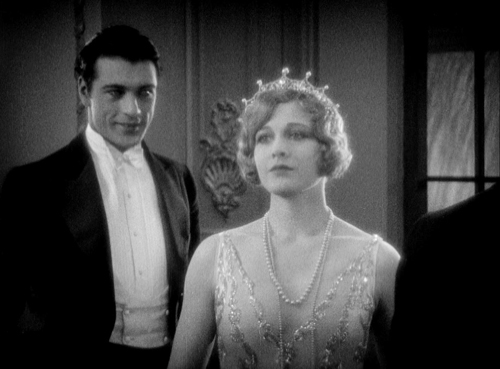
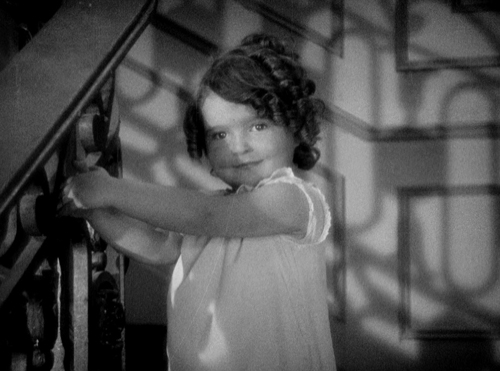
These are the only shots that one could argue contained strongly Sternbergian shadows. The opening scene in the convent as Kitty’s mother leaves her has a shadow of an offscreen window on the wall at the center of the shot, but surely one could not be certain that an image directed by Lloyd could not have such a modest shadow simply to create the atmosphere of the setting.
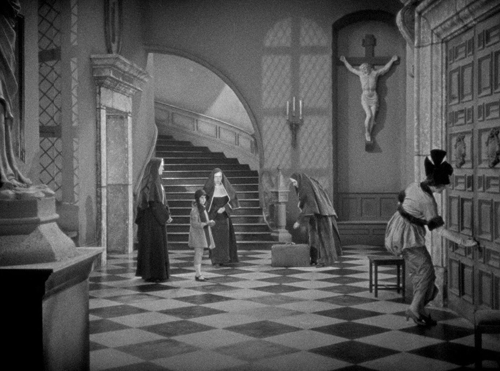
Indeed, it seems like a typical shot from an A picture of the mid-1920s.
I do not think that one can determine which shots and scenes were redone by von Sternberg just by the lighting. “To match the scenes I wished to retain,” von Sternberg must have used the three-point lighting system that had been established as the norm during the second half of the 1910s. He did a very good job, and there are many scenes that look like they could have been shot by Lloyd or Sternberg, adhering to that same norm and of course using the same sets and costumes. Which of the two directors made this image, with its exemplary use of the three-point lighting system devised by Hollywood practitioners in the second half of the 1910s?
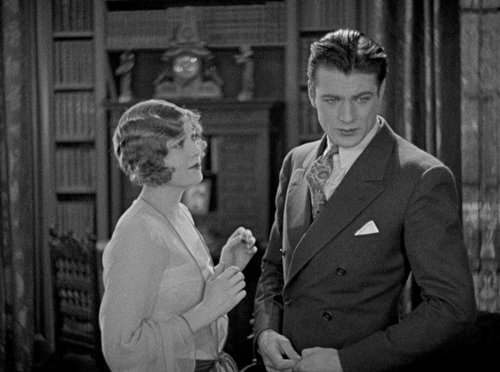
Von Sternberg’s reference to Lloyd as an “effective” director may sound like diplomatic, lukewarm praise, but he might have meant that any good Hollywood director with an experienced cinematographer could have produced such an image, with its perfect blend of key, fill, and back lighting.
Similarly, we might be tempted to identify this glamor shot of Ralston as directed by von Sternberg, but it seems a fairly conventional approach to filming a beautiful star in the late 1920s.
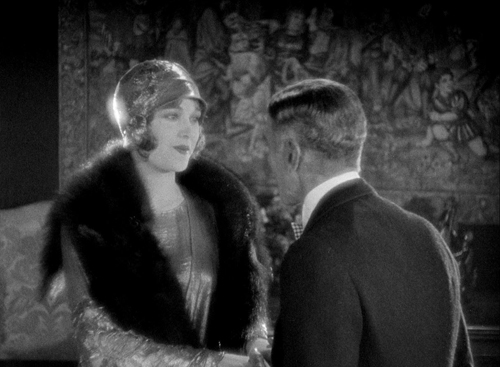
And here’s an impressive depth staging in the scene where Luco tells Kitty that he could never marry a divorced woman for religious reasons.
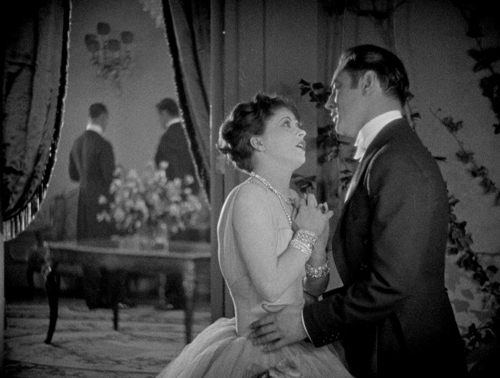
It is tempting to think that the stark juxtaposition of a sharply in-focus foreground cut off from the soft-focus background by the edge-lit fringes on the curtains is a von Sternbergian touch, but we cannot be certain that Lloyd and a good cinematographer could not create the same effect.
A possible, probable von Sternberg scene
The big climactic scene sure looks like a very skillful director made it. One is tempted to say that that director was von Sternberg.
The action brings to a head Kitty’s machinations. Having been rejected by Luco, she realizes that her refusal to let Teddy and Jean be together is making them miserable and is not the best thing for her daughter, either. She writes a suicide note addressed to Jean, hugs her daughter for the last time, and heads into her bedroom clutching a bottle of poison.
Here is a breakdown of the scene. It begins with Kitty reading a newspaper. We see her point-of-view, revealing that Luco is going to marry Jean. Luco has already rejected her, but this scene is the moment when she learns that he is to marry her friend. The newspaper shot is followed by a closer view of Kitty.
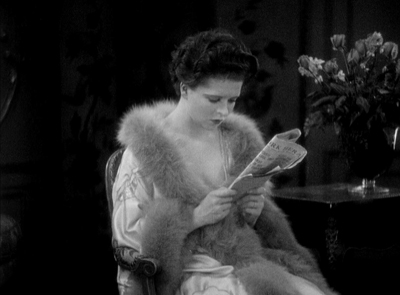 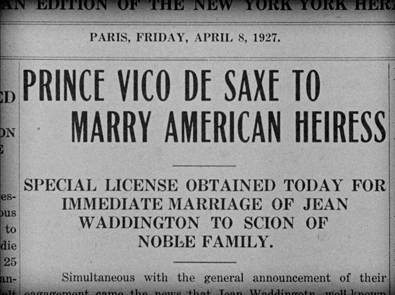 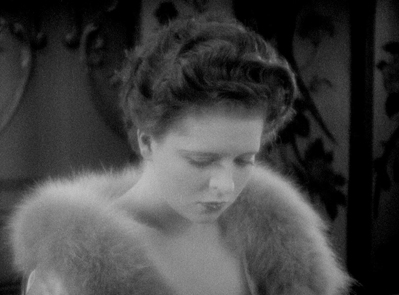
She looks up and to her right, her face grim. It is notable that Bow has been de-glamorized for this scene, with her eyebrows minimized and her hair swept back from her face in a matronly style quite different from her usual bouncy curls. The camera pulls in toward her until it is in extreme close-up.
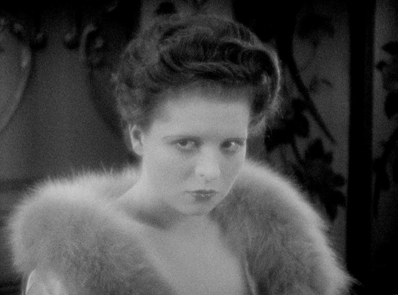 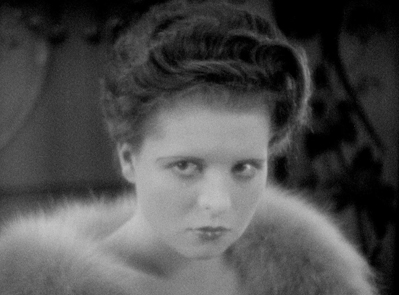 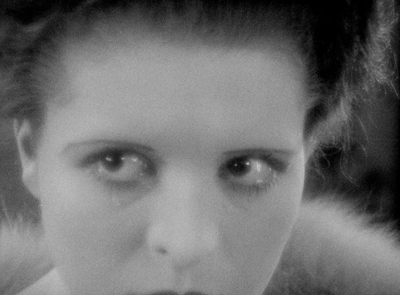
The pull-in reveals a tear that has slid down from her right eye. It is worth pointing out that this is Clara Bow, noted for her flapper image, always lively and carefree. Clearly she could play drama and even melodrama. Perhaps this is an instance of von Sternberg’s famous ability to direct female performances.
The intense close view is interrupted by a cut to Kitty dropping the newspaper. A long shot follows as she stands and moves to sit down at the desk. A cut-in to a medium shot shows her thinking and beginning to write.
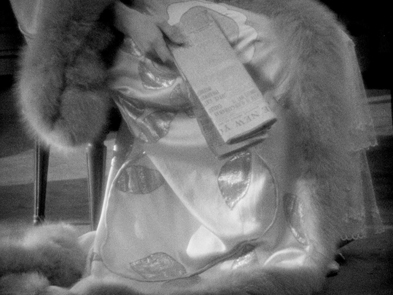  
This leads to her point-of-view on what she writes. We learn only that it is a letter to Jean and that Kitty has had a realization. A return to the medium-shot framing shows her reacting to a knock at the offscreen door and saying, “Come in” as she hides the letter under the desk-blotter. An eyeline-match cut shows her daughter entering. A pan follows as she crosses to the desk and Kitty kneels to embrace her.
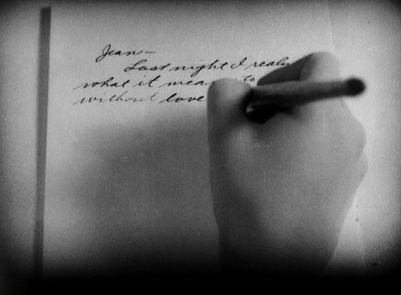 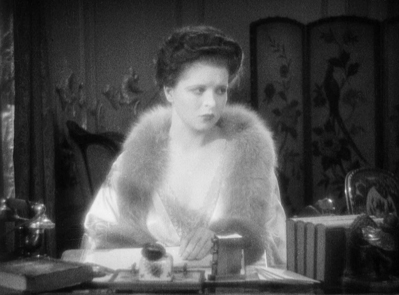 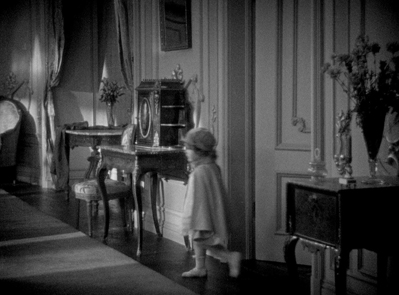
A cut-in shows Kitty emotionally embracing the girl. During the course of this, the girl’s hat falls off. In a return to the medium-long shot, Kitty carries the girl to her nurse. Another shot shows her returning to fetch the fallen hat and hugging it while displaying despair.
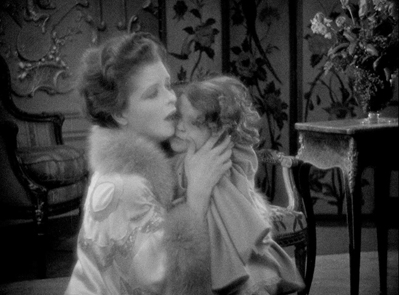 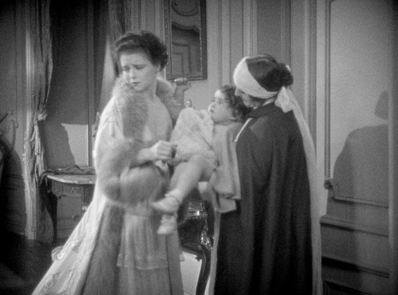 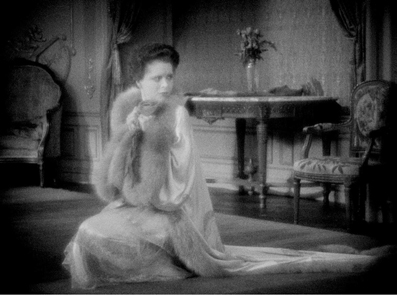
A more distant framing shows her putting the hat back on the child. The nurse’s cheery expression as she helps put the hat on contrasts greatly with Kitty’s unnoticed emotion. Once the others leave, Kitty returns to sit at the desk and pulls out the unfinished letter. Again we see her point-of-view as she completes the letter and we realize that it is an apology and suicide note, telling Jean to marry Teddy and raise the daughter that should have been hers. A return to the medium shot shows her putting the letter into an envelope.
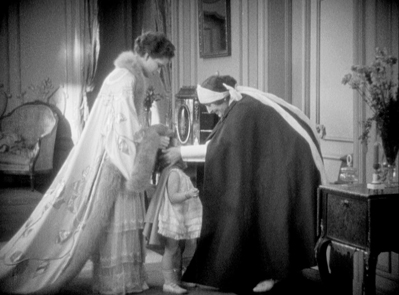  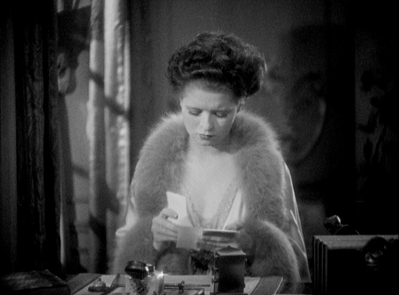
A rather clumsy and unnecessary cut-in to a tighter shot of Kitty might suggest a blend of Lloyd and von Sternberg footage is occurring, but the lighting on the set, Kitty’s hair-do and costume are identical, so the footage is probably all from the same director. A return to the previous medium shot shows Kitty hesitating as she finishes addressing the envelope and presses a button to summon a servant. A cut back to a more distant shot shows her rising and starting rightward toward the door.
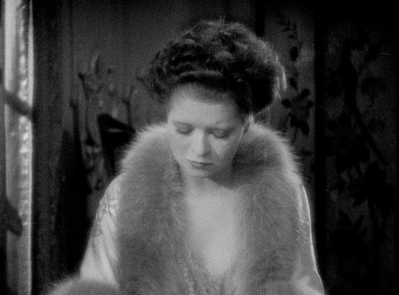 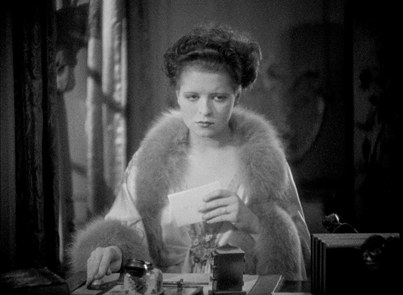 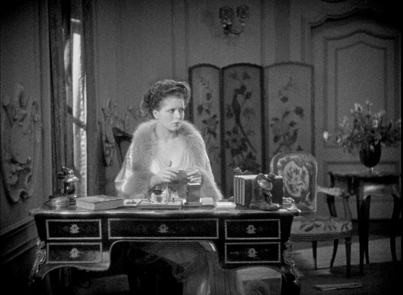
A cut to the doorway shows Kitty handing the envelope to a maid, who leaves. Kitty than moves away from the camera to reach for a small cabinet on a table. A cut-in with match-on-action shows her unlocking the cabinet and taking out an object barely recognizable as a small bottle.
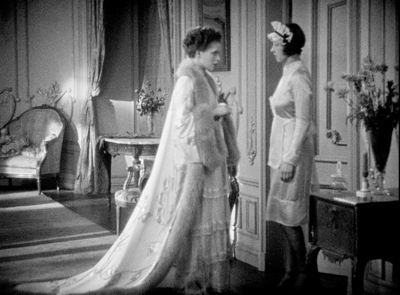 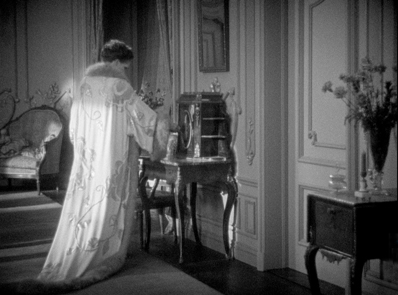 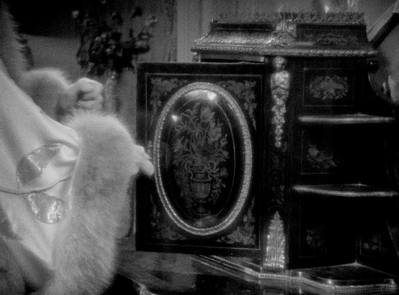
A cut to the mirror above the cabinet shows Kitty looking at herself, with the image of her face going out of focus. A cut to a medium-long shot leads to the camera panning with Kitty as she moves to a door at the rear.
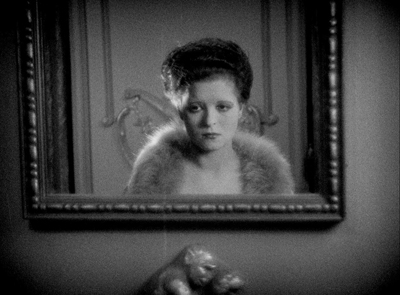 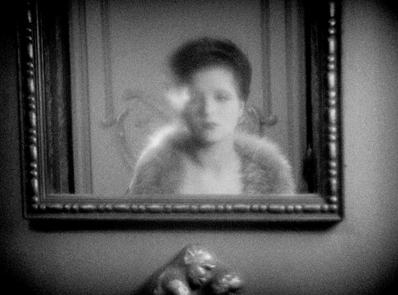 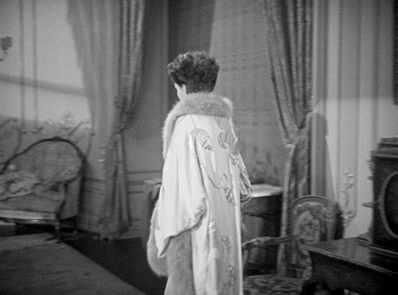
She opens the door and walks into the distance as the camera tracks slowly back.
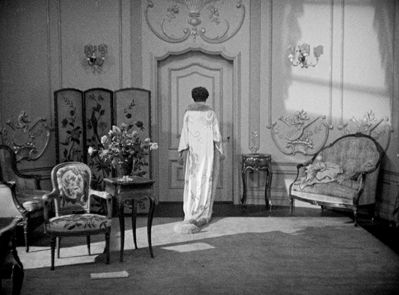 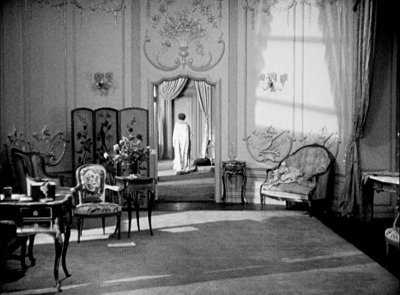
That’s a pretty flashy scene, and it certainly seems more likely than not that von Sternberg directed it.
Once again Flicker Alley deserves credit for bringing us another important film from the silent era.
Thanks to our friends at Flicker Alley for facilitating this entry.
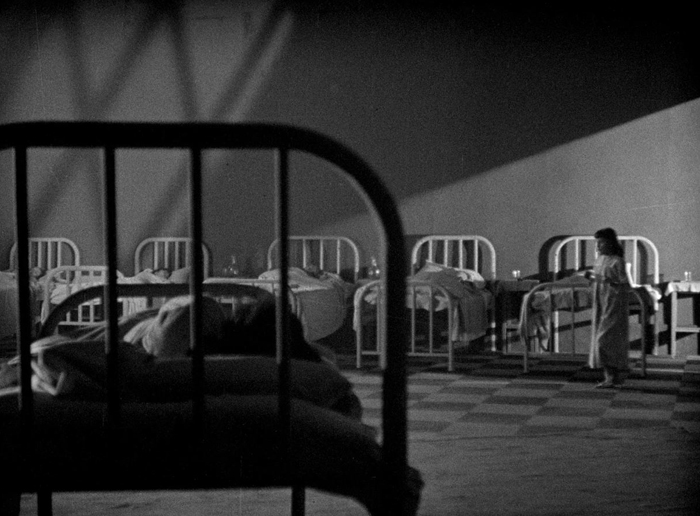
Posted in Directors: von Sternberg, Film comments, Hollywood: Artistic traditions, Silent film |  open printable version
| Comments Off on A tantalizingly anonymous Josef von Sternberg film open printable version
| Comments Off on A tantalizingly anonymous Josef von Sternberg film
Sunday | May 30, 2021
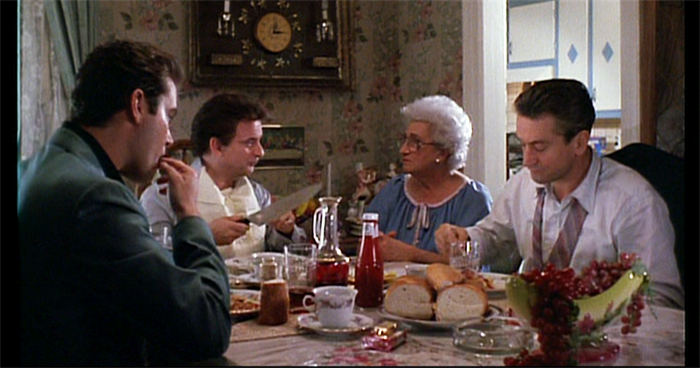
Goodfellas (1990).
DB here:
Fourteen months of being house-bound gave me plenty of chance to catch up on my reading. But the reading was almost all devoted to the book I was writing on mystery plots in fiction, film, and other media. Now that it has been catapulted out to unwary publisher’s readers, it’s time for me to catch up on some 2020 books I like. In this batch, all have a connection to film criticism, and murder, attempted or consummated, creeps into more than one.
Movies for Muggles
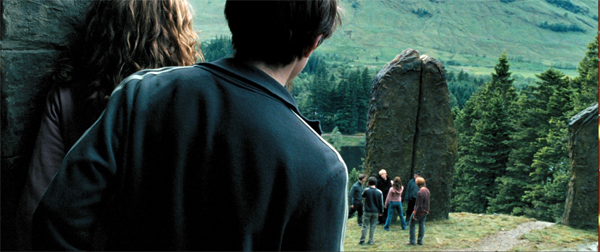
Somebody ought to write a history of the one-movie monograph. Early on there were picture books, and roadshow attractions often produced pretty laminated books as souvenirs, filled with PR stories and color images. My vote for the first analytical monograph would be the very ambitious Tu n’as rien vu à Hiroshima! (1962). In the early 1970s, American academic presses began offering critical studies of single films; an early example was the FilmGuide series edited by Harry Geduld and Ron Gottesman. (My favorite entry was Jim Naremore‘s study of Psycho.) Since then many publishers have pursued the format, usually as part of a series.
Now we have 21st Century Film Essentials, newly launched at the University of Texas Press. The first two entries are pretty canon-busting. Dana Polan writes on The Lego Movie, and Patrick Keating on Harry Potter and the Prisoner of Azkaban. I haven’t seen Polan’s book, but Keating directly takes up the challenge of the series.
As a franchise film, as a work of digital cinema, as a work of collaborative authorship, and above all as a thoroughly engaging demonstration of the art of storytelling, Harry Potter and the Prisoner of Azkaban is an essential work of twentieth-first century cinema.
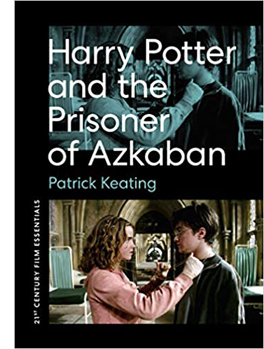 I confess I was skeptical, and still am a little. But Keating’s meticulous analysis and interpretation of the film does convince me that this is a ripe example of modern “hyperclassical” cinema. By that I mean a dense, “through-composed” revision of traditional narrative strategies and film techniques, working smoothly together to create effects at many levels. A hyperclassical film is more thoroughly classical than it “needs to be.” In other words, here’s another counterexample to the notion that “post-classical Hollywood” shows a collapse of traditional norms. I confess I was skeptical, and still am a little. But Keating’s meticulous analysis and interpretation of the film does convince me that this is a ripe example of modern “hyperclassical” cinema. By that I mean a dense, “through-composed” revision of traditional narrative strategies and film techniques, working smoothly together to create effects at many levels. A hyperclassical film is more thoroughly classical than it “needs to be.” In other words, here’s another counterexample to the notion that “post-classical Hollywood” shows a collapse of traditional norms.
Keating’s argument for the film’s richness, I think, revolves around two central concepts. First is that of narrative viewpoint. Virtually all of Azkaban, unlike the earlier entries in the franchise, is filtered through the consciousness of Harry. We’re attached to him as he experiences the action. That doesn’t, Keating hastens to add, make the film radically subjective; indeed, there are relatively few shots from Harry’s optical viewpoint. Attaching the unfolding plot to a character doesn’t rule out a wider perspective, if only because cinema puts him within a wider frame of a shot or an edited sequence. There’s always the possibility of our registering action or other characters’ reactions. The end of the Quidditch flight is thick with these impacted viewpoints, and elsewhere Cuarón’s constantly moving camera nudges us toward implications that supplement, or sometimes contradict, what Harry is concentrating on.
Keating’s other main concept is connected to the broadening of viewpoint: worldbuilding. This idea is obviously central to Rowling’s achievement, as it has been to franchises since Star Wars. But Keating lifts the idea to a central role in how films engage us. The richly realized world of Potter is only an extreme instance of what every narrative does. Borrowing from critic V. F. Perkins, Keating suggests that any film narrative supplies us with the possibility of many stories that are only hinted at, or merely latent.
Most movies prune those secondary offshoots, the better to force us to concentrate on our protagonist. But Tom Stoppard showed that Rosencrantz and Guildenstern deserved their own play. Similarly, franchise films, with the ever-present prospect of sequels, crossovers, or reboots, make us aware that any character, even any item of furniture, secretes a new story, or a bunch of them. The Potter films are committed to this spinoff aesthetic, packing in as many suggestions of sidestories as the screen will bear. This principle finds tangible expression in the portraits jammed into the Gryffindor common room and dorms guarded by the Fat Lady.
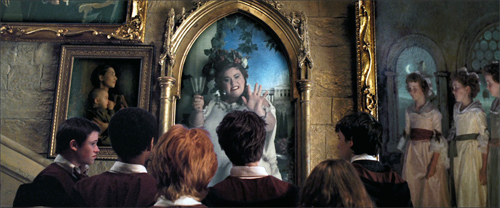
Overwhelming us with characters and situations, many in motion, this gallery is perfectly in keeping with English traditions of floor-to-ceiling decor. It’s also a groaning feast of other stories that could yet, somehow, intersect with Harry’s fate. Keating’s shrewd commentary on worldmaking is one of the book’s highlights.
Keating ties these ideas to phases of production and division of labor, reviewing how the novel’s viewpoint and worldbuilding strategies are transposed and extended by script, camerawork, editing, performances, set and costume design, and music. Throughout he weaves what he takes to be the film’s binding theme, that of time. Is the future preordained, as Ms. Trelawney insists in her frantic, fumbling lectures? Or is it open, as Hermoine and others tell Harry? This makes the film’s tour de force climax with the Time Turner into a synthesis of restricted viewpoint (we’re with Harry as he witnesses an alternative future) and worldbuilding (the future is what you make it).
I might quarrel with Keating’s suggestion that the impulse driving Harry’s action is a struggle with the dementers. I saw his relation to Sirius Black as more than the subplot Keating considers it. Overall, though, Keating has produced not only a subtle, supple analysis of the film but also a model for how to understand cinematic storytelling in the age of the blockbuster.
Wiseguy’s progress
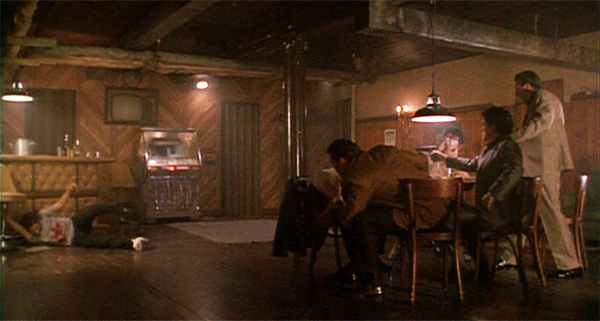
If Keating’s book is a classical sonata, Glenn Kenny’s Made Men: The Story of Goodfellas is bop. Keating offers a tidy analysis through crisply defined categories. Kenny provides a hardcopy approximation to a packed DVD.
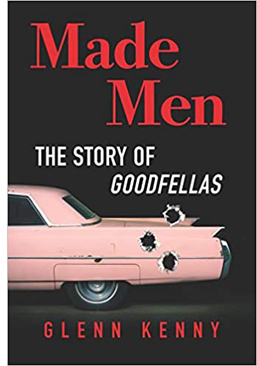 At the center is a 150 page scene-by-scene account of the film: a commentary track in your hands. Alongside that sit chapters that function as bonus materials. They include a brief introduction to the filmmaker just before he started work on the film, chapters on preproduction, the music (Kenny is an expert on pop and rock), the editing, the critical reception, and the ultimate fate of the real-life protagonist Henry Hill. Then, like the narrator of a Criterion video supplement, Kenny surveys Scorsese’s career after Goodfellas. Finally, an epilogue is virtually a monologue: Scorsese talks almost without interruption for twenty-five pages, as if this were the interview rounding off the disc. There’s also a bibliography, a timeline of the production, and the recipe for Henry Hill’s ziti. At the center is a 150 page scene-by-scene account of the film: a commentary track in your hands. Alongside that sit chapters that function as bonus materials. They include a brief introduction to the filmmaker just before he started work on the film, chapters on preproduction, the music (Kenny is an expert on pop and rock), the editing, the critical reception, and the ultimate fate of the real-life protagonist Henry Hill. Then, like the narrator of a Criterion video supplement, Kenny surveys Scorsese’s career after Goodfellas. Finally, an epilogue is virtually a monologue: Scorsese talks almost without interruption for twenty-five pages, as if this were the interview rounding off the disc. There’s also a bibliography, a timeline of the production, and the recipe for Henry Hill’s ziti.
It’s overwhelming. Kenny has evidently read everything about the real-life sources of the story, and his interviews turn fan service toward crime reporting. It is no small thing to pursue hard cases who were recruited for bit parts. Kenny has also garnered a lot of information from staff like AD Joseph Reidy, who are seldom given much attention. Keating would probably be happy to see Kenny’s narrative splinter into stories leading to other stories, such as the effects of the film on the careers of Barbara De Fina and Ileanna Douglas.
I compared the book’s central chapter to a DVD commentary. Anybody delivering a voice-over play-by-play regrets that you have to keep up with the film and can’t devote as much time to a big scene as you might like. Thanks to the print format, Kenny is able to pause the film and spiral out from it to fill in backstory or behind-the-scenes dynamics.
Early on, he can give us three pages on Tuddy, both his original (who died in prison) and Frank DiLeo, the actor playing the role. Kenny explains that DiLeo was a music executive who oversaw Michael Jackson’s “Bad” video, which included a Wanted poster of Scorsese in a subway scene, which ties to a sneaky reference to the “Smooth Criminal” video featuring a character named Frank Lideo, played by Joe Pesci. . . well, you get the idea. Likewise, in an astonishing cadenza, Kenny identifies every actor and wiseguy in the long POV tracking shot in the Bamboo Lounge.
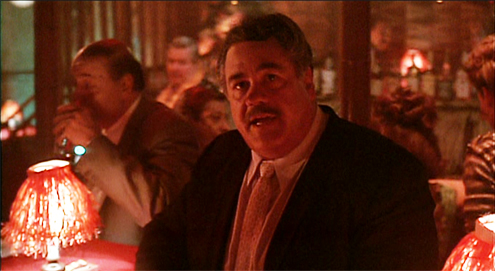
His account of the cast rummages through filmographies and personal histories, and adds the sort of oversharing we welcome: “Behind the placid mook mug seen in the movie was a remorseless killer.”
All these exfoliating tales don’t conceal a sustained performance of film criticism. Kenny’s governing idea is that Goodfellas cons us through a bait and switch. Lured in by a rapid-fire opening that arouses a bemused attraction to these bad boys, we’re gradually forced to a more sober, even horrified, realization of their moral and emotional brutality. I think that this fairly reflects most viewers’ experience. But how does the trap work?
Kenny plots an “arc of disengagement” between the killings of Tommy and Spider. A rise-and-fall pattern links the parallel scenes of the Bamboo Lounge, the Copacabana, and the shabby tavern where the gang meets to whack Morrie. Kenny draws nuanced comparisons with The Godfather and is very detailed on Scorsese’s visual techniques, particularly the freeze-frames and fadeouts, which usually get less attention than the flashy camera moves. One of the book’s main points is that Scorsese, newly aware of how TV commercials trained viewers in quick pickup, deliberately decided to make his fastest-paced movie. And of course the music is central to managing our mood and commenting on the story.
As a seasoned reviewer, Kenny can write. “Frisky newlyweds still hot for each other; you love to see it.” Henry (“a walking appetite”) eventually pulls Karen into his schemes: “The revitalized marriage will find its sense of twisted teamwork.” And digression is welcome when it humanizes the author. Listening to Sid Vicious’ version of “My Way” is comparable to “say, eating the fried chicken from the Kansas City restaurant Stroud’s for the first time.” (The “say” makes the sentence.) A movie about food begs the critic to sample a little synaesthesia, with music evoking mouth-watering chicken. Come to think of it, that linkage of music and food is in Goodfellas too.
I especially enjoyed Kenny’s rebuke to fans who bust this carefully constructed work into “movie moments.” You probably know that one school of criticism thinks that films are more or less loose assemblages of scenes, out of which certain instants become incandescent. Certainly there are such moments in many movies, and sometimes they stand out from a gray pudding. But often strong moments ravish us because they’ve been prepared for by careful craft. So Kenny’s guided tour of Goodfellas shows its affinities with Keating’s holistic approach:
Serrano and his crew reduce movies to anthologies of “cool” or shocking moments, as opposed to fictions whose circumscribed worlds aspire to create beauty or sorrow or horror or joy in some formally coherent whole.
Mon semblable, mon frère.
Dead end at the ocean’s edge
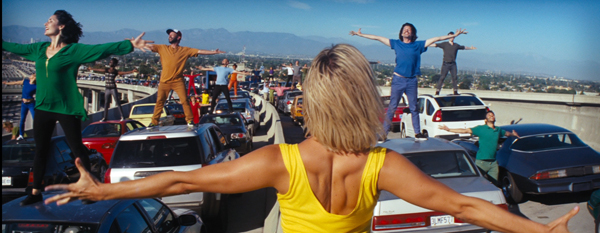
La La Land (2016).
On the other hand, I ought to be out of sympathy with Mick LaSalle’s Dream State: California in the Movies. It’s unabashedly reflectionist, tracing how films project contradictory images of the Golden State. The screen image of California promises pure self-fulfillment, but that leads to loneliness, danger, conformity, and loss of dignity. If Kenny and Keating see movies as made by an army of artisans, LaSalle treats them as springing full-blown from American mythology. There is barely a mention of a director, let alone a sound mixer, in his account.
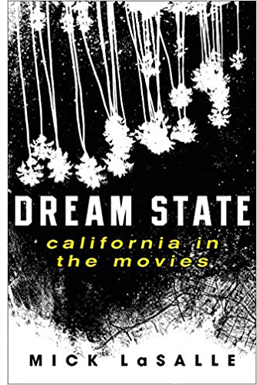 Instead, California-ism makes its way to the screen through a surge of a “collective mentality.” For instance, the blockbusters’ endless images of urban annihilation spring from “a people disseminating and celebrating visions of their own obliteration. . . . Something is seriously wrong with the nation producing such visions.” He suggests that “the fear of extraterrestrials is the disguised fear of illegal aliens. . . . the fear of the apocalypse is the disguised fear of terrorism.” Hollywood takes dictation from mass anxieties. Instead, California-ism makes its way to the screen through a surge of a “collective mentality.” For instance, the blockbusters’ endless images of urban annihilation spring from “a people disseminating and celebrating visions of their own obliteration. . . . Something is seriously wrong with the nation producing such visions.” He suggests that “the fear of extraterrestrials is the disguised fear of illegal aliens. . . . the fear of the apocalypse is the disguised fear of terrorism.” Hollywood takes dictation from mass anxieties.
I’ve explained elsewhere (here and here) why I find such claims unpersuasive. I think that reflectionism is every smart person’s mistaken idea about cinema. But sometimes, as with Susan Sontag’s essay “The Imagination of Disaster,” a reflectionist account of a film can activate some valuable ideas and information along the way, and it can host some entertaining writing. These benefits, I think, emerge throughout Dream State. In kaleidoscopic bursts, LaSalle provides suggestive takes on movies familiar and obscure, and the way they link to one another.
For example, he tracks recurring plot patterns. There’s California’s version of the One Great Night, when individual transformation takes place in a few hours of turbid activity (Superbad, Modern Girls). American Graffiti is the prototype, and in just two pages LaSalle evokes the way audience knowledge races ahead of the characters, far into the future. (Curt winds up in Canada, which probably has to be explained to young viewers today.)He’s very good on the cost-of-stardom plot, from What Price Hollywood to La La Land, this last the only film that faces the fact “that every great advance requires sacrifice, and that even though there is nothing like the joy of first love , there is nothing more important than the fulfillment of one’s inner self.”
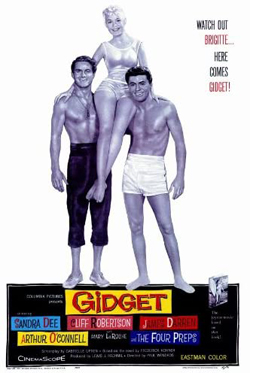 LaSalle considers our willingness to take stars as surrogates for us, and here I was reminded of another critic who tried to pierce the Hollywood Hallucination, the great Parker Tyler. He had, I think, a more meta attitude toward the movies, since he avoided straight reflectionism by treating every film as a charade, a narcissistic exercise in make-believe. For Tyler, Hollywood movies were always primarily about Hollywood, filled with symbolic surrogates for their makers and their viewers. In this respect, LaSalle’s opening chapter is agreeably Tyleresque, positing The Wizard of Oz as a film enacting the flight to a dream city; the Emerald City as Hollywood. Like Tyler as well, LaSalle searches for what he calls a movie’s complex finish, as with a glass of wine. Wizard ends not on a note of ambiguity exactly, but on something like a chord that sets off contrary overtones. Tyler’s books were built on this chord. LaSalle considers our willingness to take stars as surrogates for us, and here I was reminded of another critic who tried to pierce the Hollywood Hallucination, the great Parker Tyler. He had, I think, a more meta attitude toward the movies, since he avoided straight reflectionism by treating every film as a charade, a narcissistic exercise in make-believe. For Tyler, Hollywood movies were always primarily about Hollywood, filled with symbolic surrogates for their makers and their viewers. In this respect, LaSalle’s opening chapter is agreeably Tyleresque, positing The Wizard of Oz as a film enacting the flight to a dream city; the Emerald City as Hollywood. Like Tyler as well, LaSalle searches for what he calls a movie’s complex finish, as with a glass of wine. Wizard ends not on a note of ambiguity exactly, but on something like a chord that sets off contrary overtones. Tyler’s books were built on this chord.
Another critical avenue that LaSalle opened up for me was iconographic: the differences between LA movies and San Francisco movies. He deftly contrasts the ambience and topography of the cities. Noir and disaster films are primarily anchored in LA, while San Franciso movies tend to be steeped in nostalgia (e.g., Jobs, Milk). He keeps finding new angles to comment on. Avoiding the obvious effort to discuss California’s boom during and after the war, he skips back to the months around Pearl Harbor to bring to light films, mostly exploitation quickies like Secret Agent of Japan and Little Tokyo, USA, that rushed to treat Japanese Americans as potential spies. Meanwhile, the unoffending citizens were shipped off to internment. On a lighter note, anybody who’s bold enough to praise Gidget as a more mature film than Easy Rider gets my admiration (and agreement).
LaSalle, who came to California from the east, weaves in bits of memoir that highlight his main theme. And like Kenny, he writes with conversational wit.
“Home is horrible. Oz is horrible, too. . . but at least it’s in color.”
On Saturday Night Fever and Grease: “One seems tough, but it’s soft. (Of course, that’s the New York film.) One seems soft, but it’s hard. (Of course, that’s the Los Angeles film.)”
In Hollywood “integrity is so original it might just work as a strategy.”
In Out of the Past, “sex can kill you, but it’s worth it anyway.”
In San Francisco (1936) “if only to get Jeanette MacDonald to stop singing, the Earth had to intervene.”
Contrasting Monterey Pop to Woodstock‘s utopian fantasy, LaSalle nearly had me on the floor.
This is a model? Hundreds of thousands of intoxicated people, unable to wash, all but sitting in their own slop, cheering for a series of aristocrats that swoop down to entertain them and then leave? Meanwhile, the army flies in food and the slave classes clean out the Port-O-Sans? That’s sustainable as a societal model?
In addition to all this, through engaging appreciation, LaSalle has prompted me to seek out a great many films I hadn’t heard of. That’s another duty of the good critic. After seeing so much–pounding the beat every day–the movie reviewer can steer you to new discoveries.
Cinephile into cineaste and back again
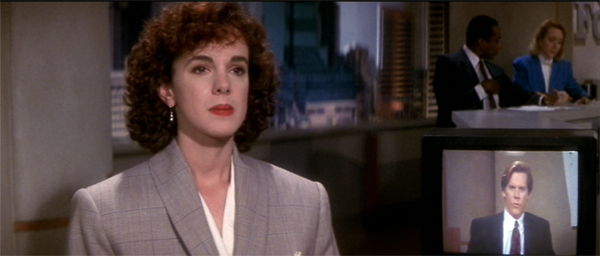
He Said, She Said (1991).
All of these critics have participated in filmmaking. Mick LaSalle has written and produced documentaries. Glenn Kenny has been an actor in several films (including Soderbergh’s Girlfriend Experience). Patrick Keating, who has an MFA in cinematography, has been a DP on independent projects. Reciprocally, director Ken Kwapis started out wanting to be a film critic–in third grade, no less.
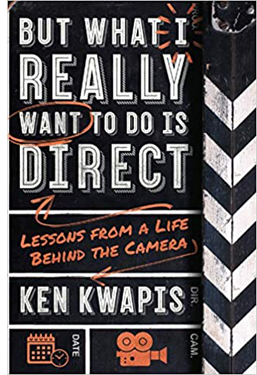 In college he devoured classic movies and gorged on film criticism. Kwapis went on to become a director of consequence, overseeing many features (Sisterhood of the Traveling Pants, He’s Just Not That into You) and TV episodes (The Garry Shandling Show, The Office). Yet he didn’t leave his cinephilia behind. But What I Really Want to Do Is Direct: Lessons from a Life behind the Camera has an intellectual heft rare in career memoirs and moviemaking manuals. It’s at once thoughtful and practical, suffused throughout by an ethic of modesty, tenacity, and what I can only call a desire to remain both a good artist and a decent person. It also contains some first-rate film criticism. In college he devoured classic movies and gorged on film criticism. Kwapis went on to become a director of consequence, overseeing many features (Sisterhood of the Traveling Pants, He’s Just Not That into You) and TV episodes (The Garry Shandling Show, The Office). Yet he didn’t leave his cinephilia behind. But What I Really Want to Do Is Direct: Lessons from a Life behind the Camera has an intellectual heft rare in career memoirs and moviemaking manuals. It’s at once thoughtful and practical, suffused throughout by an ethic of modesty, tenacity, and what I can only call a desire to remain both a good artist and a decent person. It also contains some first-rate film criticism.
Kwapis intercuts three sorts of chapters. There is the chronological account of the filmmaking process, with advice on taking meetings, establishing rapport on the set, giving actors “playable notes,” and coping with postproduction and marketing. Kwapis insists at every turn that you need to be both firm and flexible, open to every suggestion from the production team but still adhering to your conception of the project.
But this is not auteurism on steroids. If you’re not a Spielberg or a Nolan, the director has to learn tact and strategy. Kwapis emphasizes not abstract technique but the interactive, interpersonal demands of filmmaking, He suggests ways of responding to producers’ notes or actors’ complaints that allow everyone to keep their dignity. Just stepping away from the Video Village, that cluster of people around the monitor, and positioning yourself by the lens is a way of proactively steering the scene. He even gives good advice about bad reviews. His creative process? “I want to stand behind the camera and make sure there’s something alive going on in front of it, something recognizably human.”
A second batch of chapters shows this aesthetic/ethos in action through case studies from Kwapis’ career. Starting with Follow That Bird (1985), the Big Bird movie, and running up to A Walk in the Woods (2015), these chapters are about concrete problem-solving. How do you direct puppets? Or orangutans? Or Rip Torn? How do you support an actor who’s just not physically up to the role? There’s a fascinating account of staging options in The Office, where different situations force choices between developing the action in the “bull pen” or in the conference room.
The 1990s were rife with narrative experiments, and He Said, She Said (1991) was one of them. Unfolding over two days, its first part uses flashbacks to present Dan’s memory of his romance with Lorie, while the second part shifts to her version, with replays and gap-filling scenes that show the biases of his account. Kwapis and his wife Marisa Silver (Permanent Record) decided to divide responsibilities, with him directing the man’s scenes and her directing the woman’s. They also built in stylistic differences.
We pre-visualized each version to create as much contrast between Lorie’s and Dan’s personaities as possible. For example, I often show Dan’s literal point of view of Lorie, while Marisa uses camera movement and choreography to underscore how Lorie feels about herself (i.e., insecure).
They created specific ground rules for shooting the scenes. Kwapis’ portion came first, so that Silver could see it and fine-tune the replay. Kwapis is admirably specific about how their strategy shaped performance and plot, with minor characters in one half becoming major in the second.
In other words, a cinephiliac idea. (Kwapis prepared for his task by watching Rashomon, The Killing, and Citizen Kane.) The third type of chapter he offers is pure, sharp film criticism, always informed by the demands of craft. His account of American Graffiti is quite different from LaSalle’s, but no less appealing, emphasizing Curt’s visit to Wolfman Jack as an epiphany that needs no formal underlining (“no ham-fisted push-in”).
Other chapters scrutinize 2001, Lawrence of Arabia, The Graduate, I Vitelloni, and other classics. Without being pretentious Kwapis manages to invoke the “objective correlative” (e.g., shoes in Jojo Rabbit) and reflexivity (no big deal). I especially appreciated his detailed analysis of staging in a scene often overlooked in The Magnificent Ambersons: George’s confrontation with a gossipy neighbor, handled in one deftly choreographed close framing.
Kwapis designed the book to explore these three dimensions, but he isn’t puritanical about keeping them apart. Case studies and problem-solving pop up in the general advice sections, and the critical acumen shines through even brief examples of on-set tips (e.g., decisions about a score for Traveling Pants). It all flows together.
The result ranks with Sidney Lumet’s Making Movies and Alexander MacKendrick’s On Film-Making, the most acute personal reflections on Hollywood directing. But like those, it’s more than a testament to the power of craft. It’s also a vision of how, as the first chapter says, to go “beyond success and failure in Hollywood.” You do it, Kwapis maintains, by knowing your plan, respecting your co-workers, inviting discovery through accidents, and staying humane. I like to think that studying films as a critic helped him get there. Not every director, after all, can quote Jean Renoir.
“Only a hack cares about the goddam script”
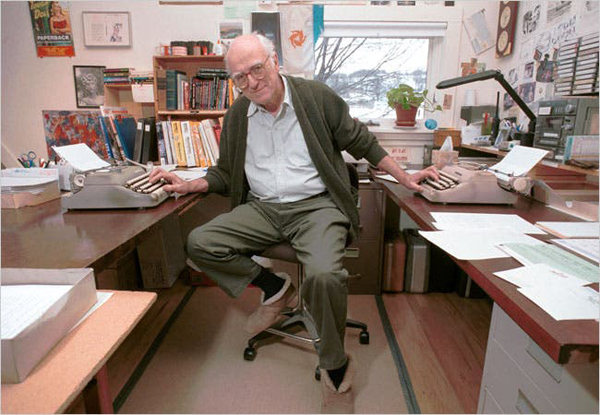
Donald Westlake (David Jennings for the New York Times).
I promised you a murderer, and he arrives in Donald E. Westlake’s Double Feature, a pair of novellas originally published as Enough (1977). The second, Ordo, takes place in Hollywood, when a sailor learns that his first wife has become a movie star and decides to look her up. It’s remarkable in several ways, but the story that grabbed me was A Travesty. On the first page a film critic kills his girlfriend.
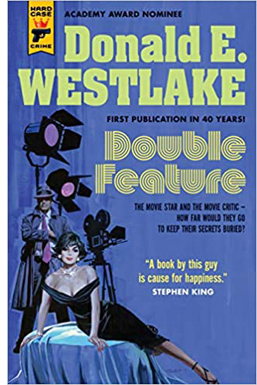 True, it’s an accident, but even then he seems less distressed than he should be. He wipes down the crime scene and slips out. Of course he becomes a suspect. Once he seems to be cleared, the trusting cop lets him mosey along on later investigations. They discover that the critic has a knack for solving crimes, including an old-fashioned locked-room puzzle. He gets caught thanks to a plot twist that owes a good deal to Westlake’s early days writing happily overblown softcore porn. True, it’s an accident, but even then he seems less distressed than he should be. He wipes down the crime scene and slips out. Of course he becomes a suspect. Once he seems to be cleared, the trusting cop lets him mosey along on later investigations. They discover that the critic has a knack for solving crimes, including an old-fashioned locked-room puzzle. He gets caught thanks to a plot twist that owes a good deal to Westlake’s early days writing happily overblown softcore porn.
The plot lives up to its title, being a travesty of whodunits and man-on-the-run thrillers. Westlake invokes mystery conventions like the dying message and the final twist: “As with all Least Likely Suspects, I was in reality the Murderer.” But this guilty protagonist is writing a profound essay on Top Hat and interviewing an over-the-hill director who undermines his belief in the auteur idea that “it’s up to the director to color and shape the material and so on.”
A: Yeah, that’s fine, but you got to have the material to start with. You got to have the story. You got to have the script.
Q: Well. . . . I thought the director was the dominant influence in film.
A: Well, shit, sure the director’s the dominant influence in film. But you still gotta have a script.
Well, that wasn’t any help. What was I supposed to do, go ask three or four screenwriters for suggestions?
A Travesty reveals that Westlake followed East Coast cinephile taste pretty closely. In the passage after this one, the killer regrets placing Brant so high in the Pantheon–a clear reference to Andrew Sarris’s writings. Better to ask a real director like Hawks or Ford or Hitchcock, or even Fuller.
Hip movie references are de rigueur in most mysteries today. (Grudge-reading The Woman in the Window, I thought: Just kill me now.) But how many thrillers in 1977 invoked Marion Davies or Manny Farber’s Negative Space? Our anti-hero argues with a girlfriend about circumstantial evidence in The Wrong Man and Call Northside 777. And as you’d expect, the big clues that reveal the killer to her come from Gaslight.
Westlake has long been one of my heroes; his Richard Stark novels get a chapter in that manuscript I mentioned at the outset. (Go here and here to gauge my dedication.) Like Elmore Leonard, he had a pragmatic approach to movie versions of his work. As far as I know, he complained only of Godard’s handling of The Jugger, which became Made in USA, not that anybody could tell. He wrote screenplays, notably The Stepfather (1987) and The Grifters (1990), and many of his stories have been adapted to the screen (Point Blank, The Outfit).
Nearly all his work I know has a zesty playfulness, and A Travesty is no different. It suggests that, after shooting down movies and destroying reputations, film critics have earned a chance to kill for real. They just turn out to be fairly bad at it.
My stack of reading has barely dwindled. I’ll try to file some more book reports as summer unfolds and the mosquitos discover our shady lawn.
Thanks to Patrick Keating and Mick LaSalle for sending me copies of their books, though I would have bought them anyway. Thanks especially to Patrick Hogan for telling me of his friend Ken Kwapis’s book.
Philip Pullman, a master of the sort of world-building Keating celebrates, argues against dwelling on the story spinoffs harbored by a richly realized milieu. He borrows the scientific idea of “phase space” to suggest that too great a concentration on the indefinitely large possibilities of a story world can freeze a narrative’s progress and distract the reader from the through-line. A story, he says, is a path through a forest and readers are best gripped by sticking to Red Riding Hood’s journey. (Compare Sondheim’s Into the Woods.) Interestingly, he compares this strategy to the cinematic idea of knowing the right spot for the camera, a spot that’s just as valuable for what it excludes as for what it shows. See Daemon Voices: On Stories and Storytelling (Vintage, 2017), 20-24, 122-123.
For more on Parker Tyler, see the chapter in my The Rhapsodes: How 1940s Critics Changed American Film Culture. Avoiding straight reflectionism, Tyler saw the film world as its own sealed-off realm. If the movies reflect anything, it’s not what America thinks but what Hollywood thinks that America thinks. Or rather, what Hollywood imagines that America dreams.
In this entry I write about some of the anti-Japanese films Mick LaSalle discusses.
This entry analyzes the pseudo-documentary style of The Office. I write about 1990s as an era of narrative experimentation in The Way Hollywood Tells It: Story and Style in Modern Movies.
No admirer of Westlake can ignore the addictive Westlake Review or, of course, the official webpage maintained by his son Paul. Westlake’s motto: “My subject is bewilderment. But I could be wrong.”
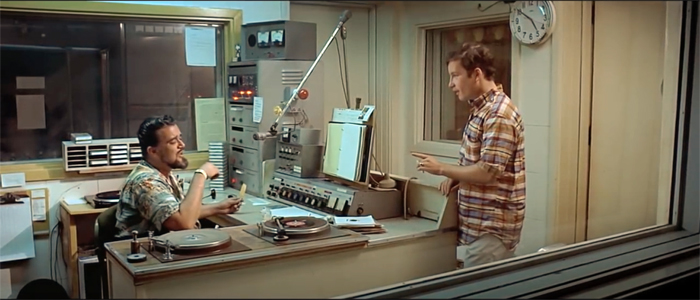
American Graffiti (1973).
Posted in Books, Directors: Cuarón, Directors: Kwapis, Directors: Scorsese, Film comments, Film criticism, Film technique, Film technique: Cinematography, Hollywood: Artistic traditions, Narrative strategies |  open printable version
| Comments Off on Five critics, one of them a killer open printable version
| Comments Off on Five critics, one of them a killer
|


























































































































































